Neighborhoods of Fuengirola
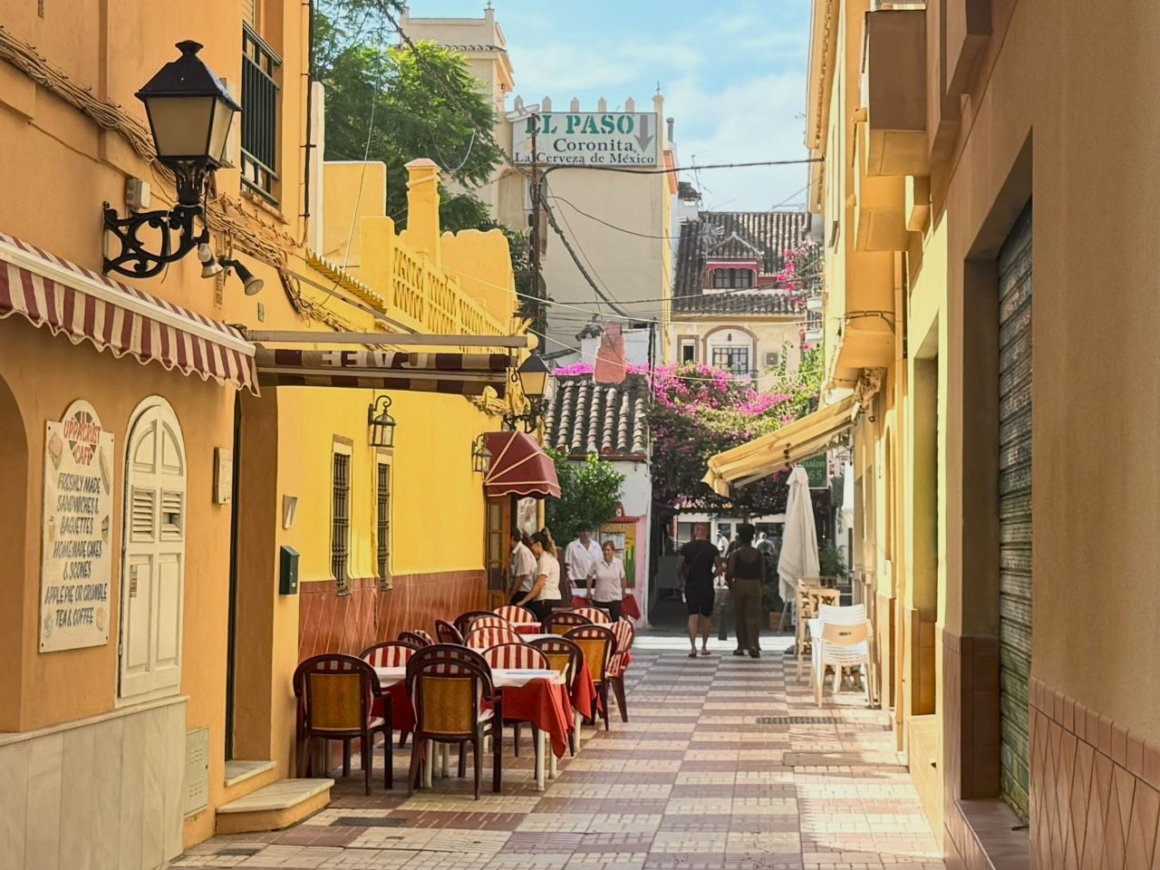
Neighborhoods of Fuengirola – Fuengirola is a lovely city in the Costa del Sol. Favorite of many visitors, for its beautiful beaches, easy of commute and relative flatness – a differential of the town in an otherwise hilly landscape – it may come as a surprise how different one neighborhood of Fuengirola is to the next. It’s definitely not all flat! Tag along for a closer look and to choose what to see in Fuengirola. 😉
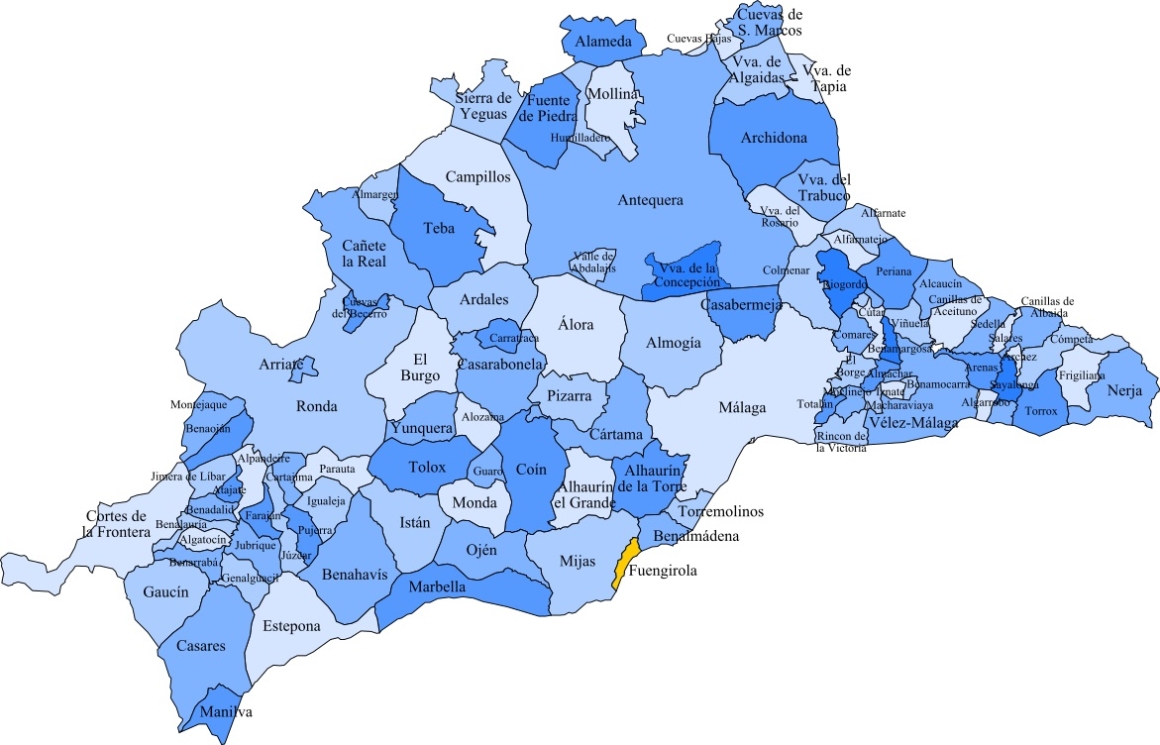
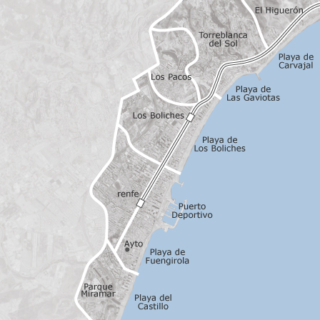
There are 9 main neighborhoods in Fuengirola, according to Idealista.com. Like for Benalmadena’s and Torremolinos’ neighborhoods, I will use Idealista’s map as a reference for the different neighborhoods for two main reasons: first, because there is no official map showing each neighborhood, and second, because for those looking into buy or rent a place in Fuengirola, it can be of good help if the information about the location matches their search location.
I coupled that with Google Maps to find the borders between Fuengirola and Mijas – often times hard! – and came up with my own map, that you see below. It is rotated to fit in a horizontal map, for ease of use; it is not official and there may be a bit of imprecision – some streets above or ahead of my lines – but I think it is a reasonable reference. I hope it is useful and, if you can improve the map, please let me know!
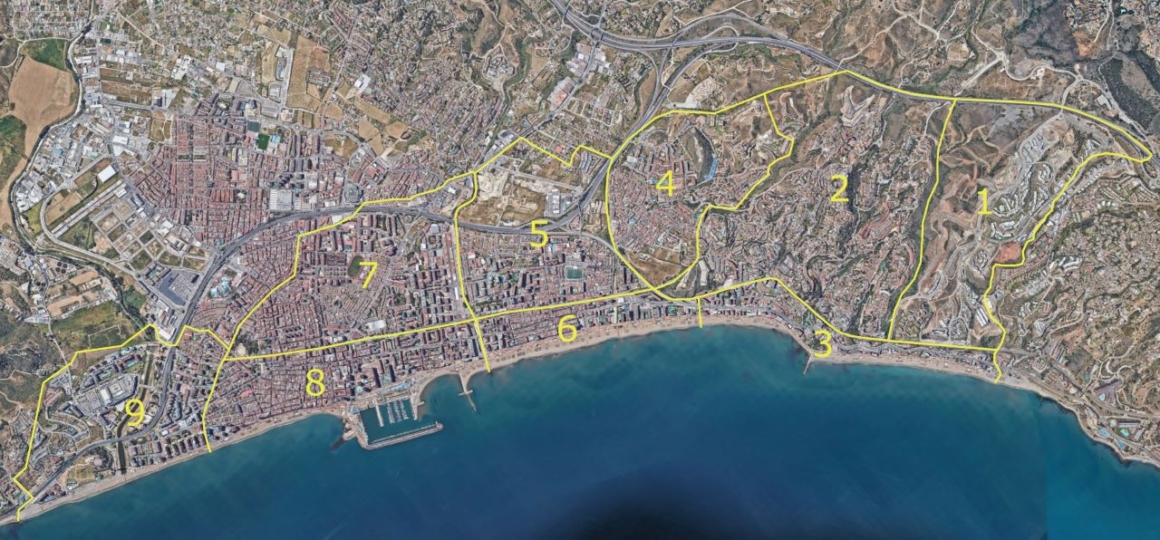
1 – El Higuerón
Fuengirola’s El Higuerón borders the namesake area in Benalmadena, but here it is a bit different. While Benalmadena’s Higuerón is mostly comprised of houses and has difficult access by road, Fuengirola’s El Higuerón is mainly comprised of apartments buildings (both ready and under construction).
El Higuerón is not flat at all, that’s for sure! But the access by car is easy. The whole area connects to Avenida de Fuengirola, which in turn goes to both the A7 (the highway of the Costa del Sol) and to the N-340, the coastal avenue that goes changing name along the way – here it is Avenida Carvajal; you may know it as Avenida del Sol or Avenida Antonio Machado in Benalmadena, or as Avenida Carlota Alessandri in Torremolinos.
The upper part (closer to the A7) is dominated by a group of buildings which belong to the same development, called Lomas del Higuerón; the lower part, closer to the beach, has several apartment complexes, many of which are visible while traveling by train, near or at the Carvajal stop.
Above: Google Street View of Avenida Fuengirola, taken in August 2024.
Lomas del Higuerón is an ambitious and ongoing development that promises the luxury of concierge services to help in everyday tasks. The area is well connected by car, but I think walking to (or from; mainly from) the nearest train Station (Carvajal) or beach would not be very comfortable; there isn’t much shade in the area, not many trees (at least as of now) and the inclination is quite considerable – more than 10% incline; definitely a cardio exercise!
This area is only accessible by car, and it is separated from the rest of Fuengirola by a valley.
2 – Torreblanca
Torreblanca is to Fuengirola what El Pinar is to Torremolinos, or what El Higuerón/La Capellania is to Benalmadena: the (very hilly) area where the large, beautiful, comfy, detached houses with pools are located.
But Torreblanca has two main advantage over the other two: it has its own train stop, Torreblanca, and plenty of bus stops.
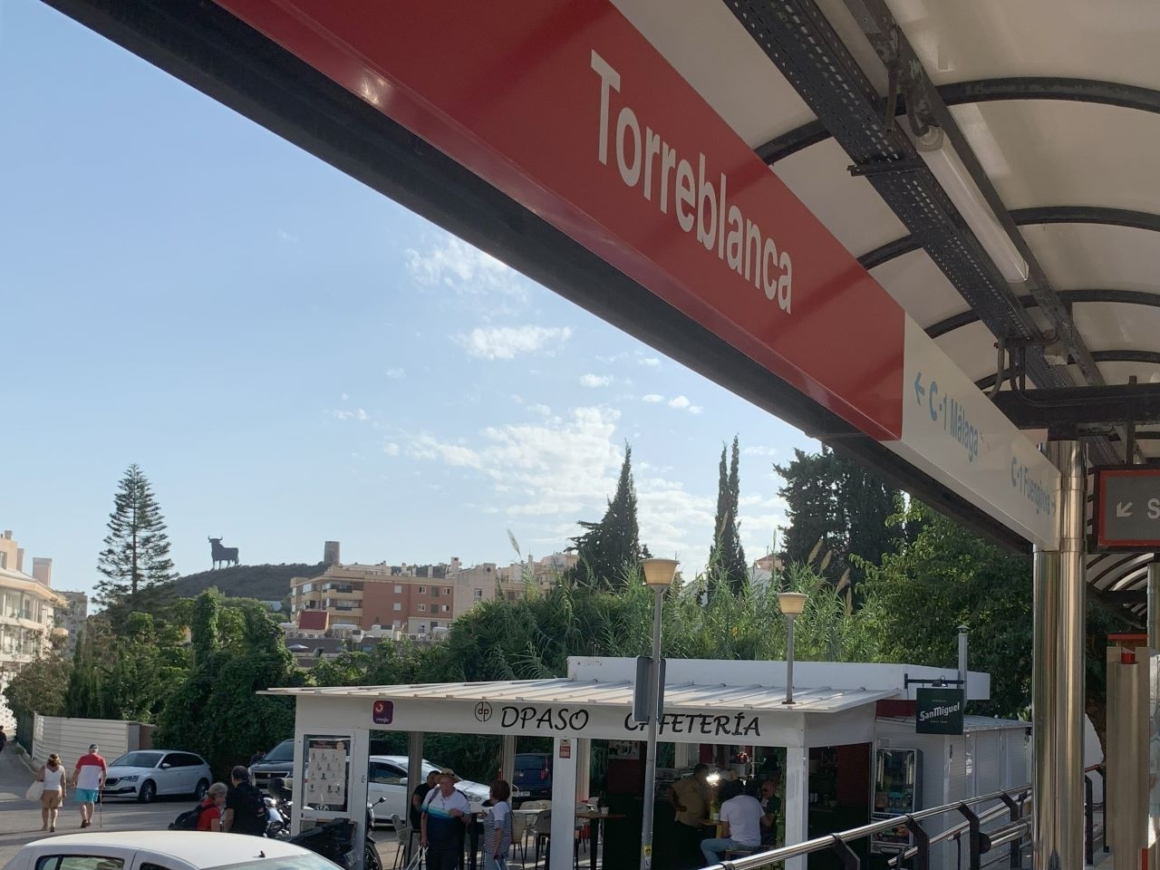
Right from the station you can spot one of the main landmarks of Fuengirola: the Toro de Osborne (Osborne’s bull), which started as a beverage ad and became a symbol of Spain. There are several bulls like this throughout the country, only 3 in the province of Malaga and one is in Fuengirola! By the way, it is possible to hike up to the bull. 😉
Not only Torreblanca has bus stops, but Fuengirola’s line 5 covers the area with buses each 15 minutes. And this bus line is free for residents!! And it is only one of the five lines free for residents in the town!!!! Fuengirola, in my opinion, has the best public transportation in the whole Costa del Sol. (The Benalmadena resident in me fully envies the Fuengirola resident in you, Dear Reader.)
Besides the detached houses, Torreblanca also has quite a few townhouses and buildings in the mix. Another distinctive characteristic of Torreblanca is that it is the part of Fuengirola with more green spaces.
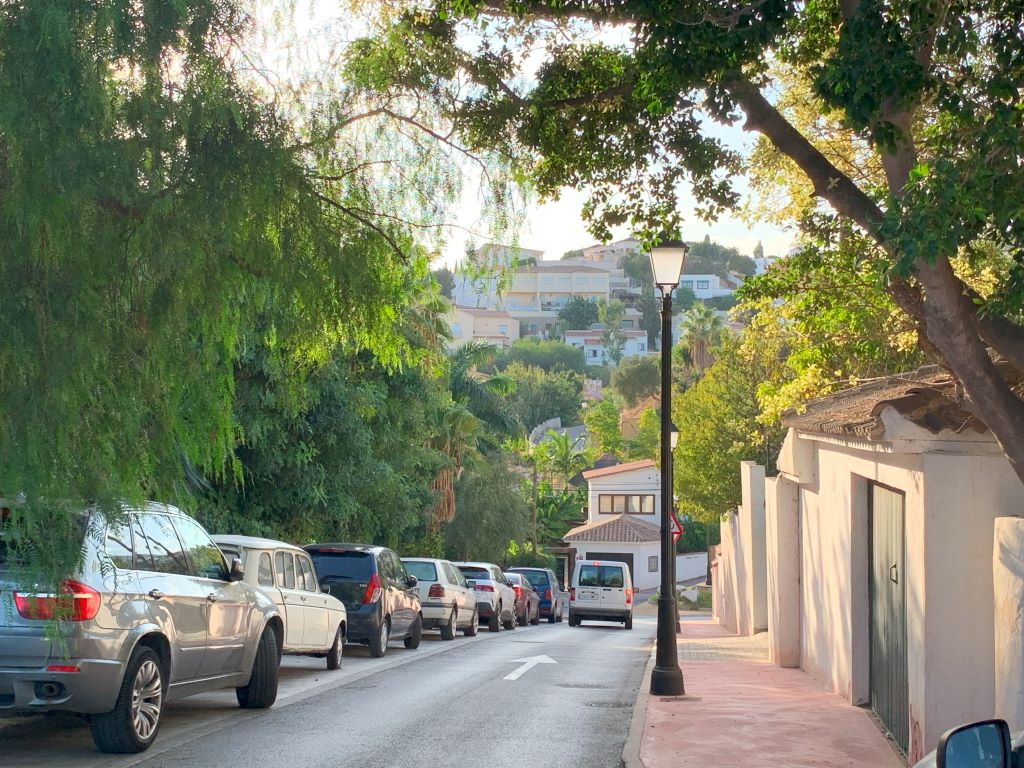
3 – Las Gaviotas
Playa de Las Gaviotas, Playa de la Torre or de Torreblanca, and Playa de Carvajal together form the area known as Las Gaviotas (I would have them separated, but I’m keeping the Idealista pattern). Together or separate, this whole area is lovely, by the beach and the promenade, well served by trains and beautiful.
All along the sandy shores in Las Gaviotas there are chiringuitos (seaside restaurants or cafes), then the large promenade, a car road – Passeo Maritimo Rey de España – then buildings – both hotels and residential buildings, these last ones with commerce on the ground level. There you’ll find lots of cafes, restaurants and bars.
The part of Las Gaviotas that borders El Higuerón is also known as Carvajal and Playa de la Torre. Carvajal beach actually extends into Benalmadena, so you can find references of this beach as being located on either town.
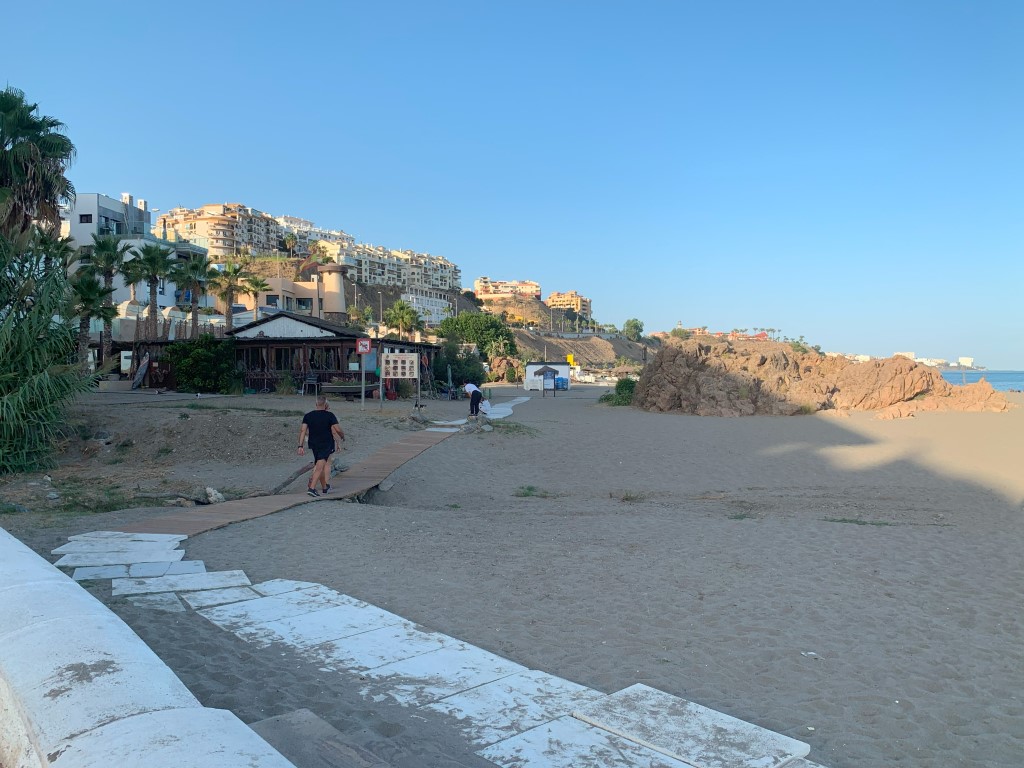
Also in Carvajal we find the end (or start) of the passeo / promedade of Fuengirola…
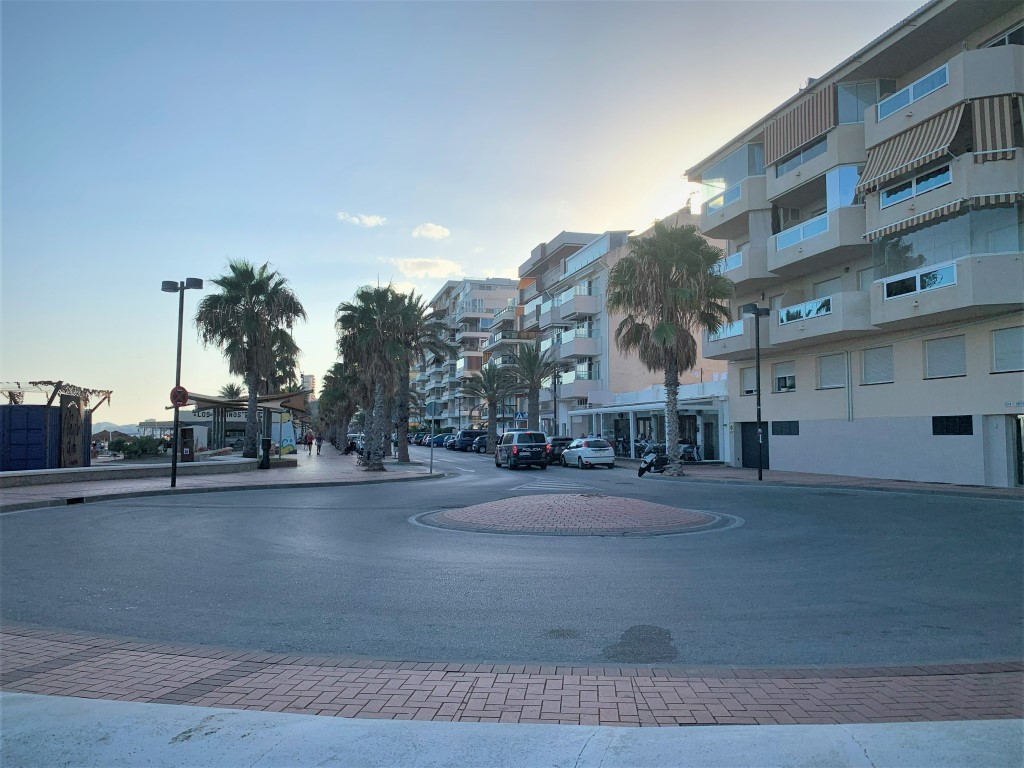
… and just one block back, the border between Fuengirola and Benalmadena.
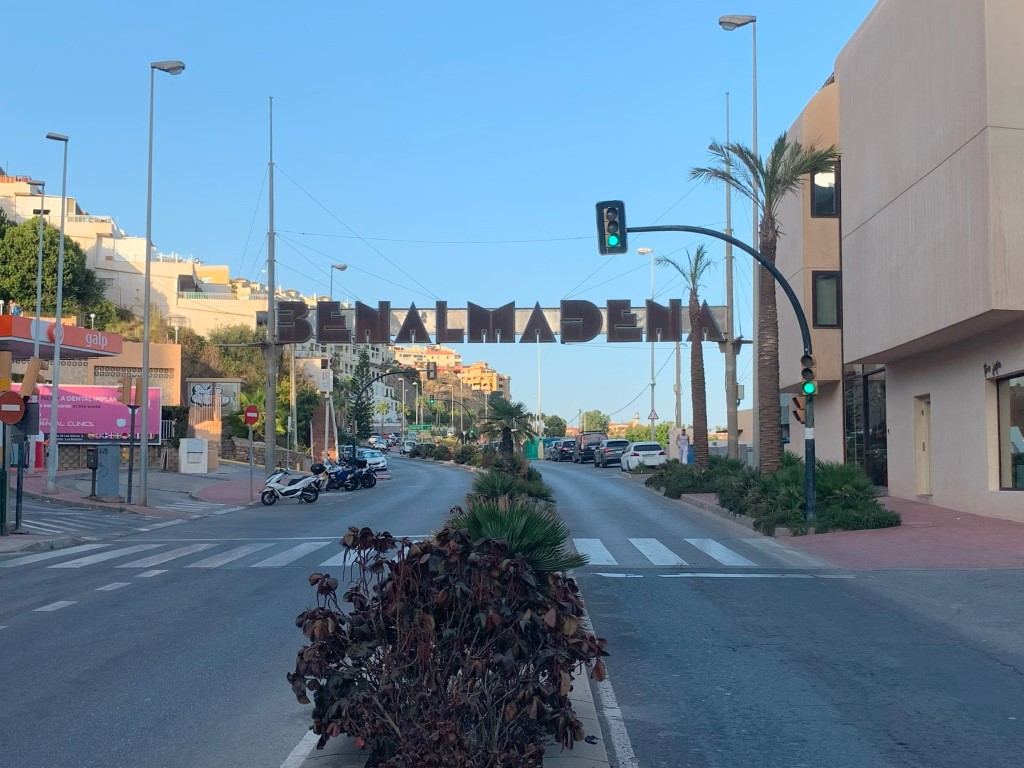
But the real star of Las Gaviotas is the large extent of sandy beach and its promenade:
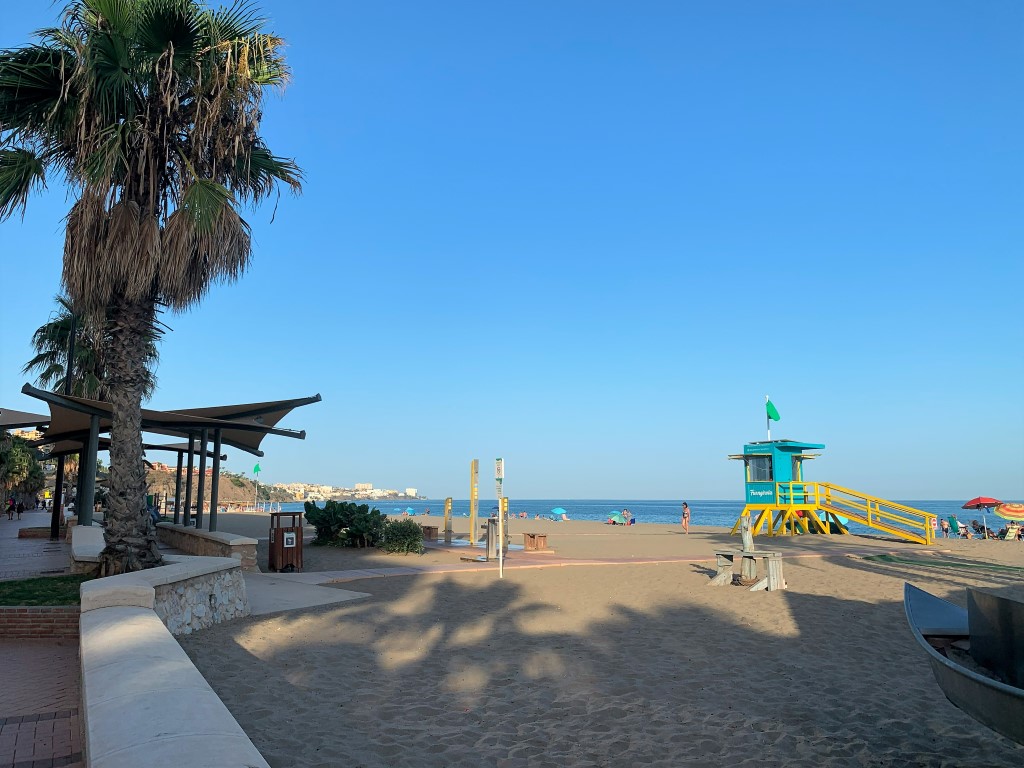
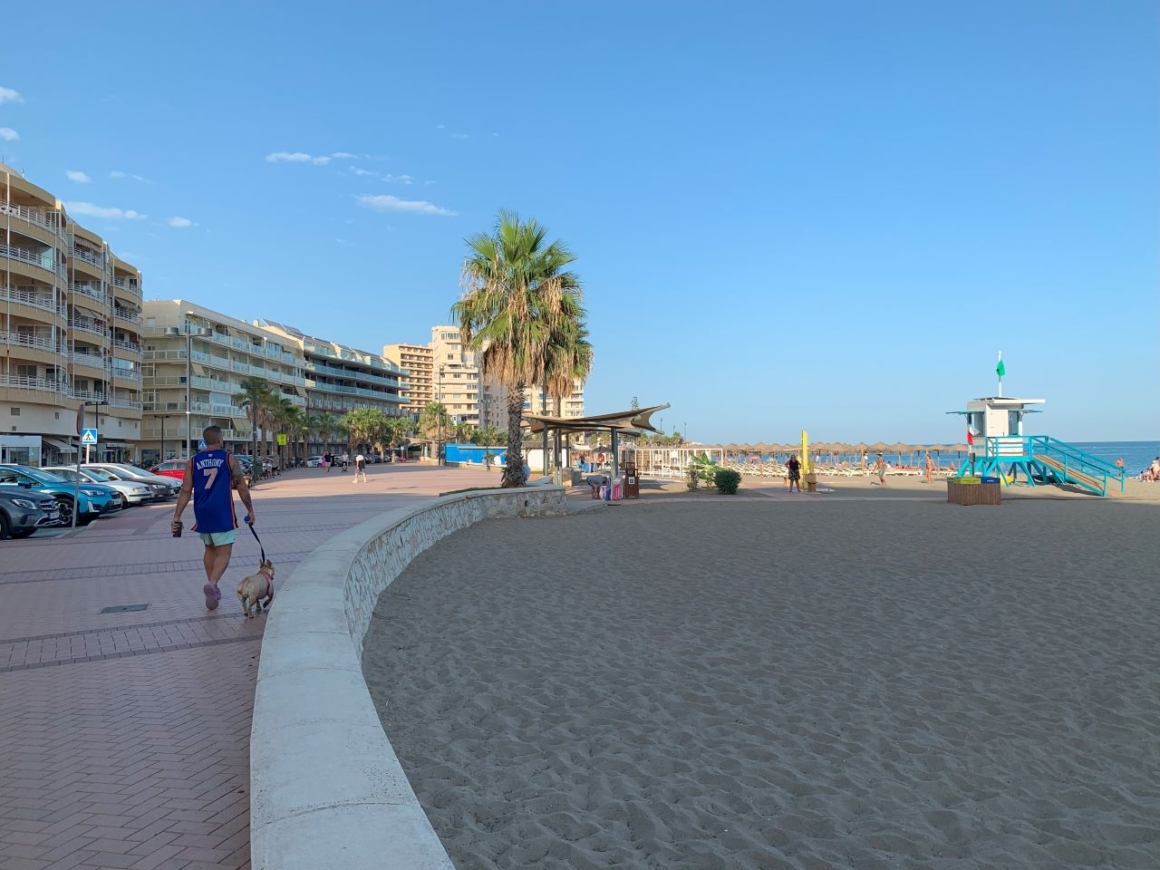
Did you notice the pergolas in both pictures above and in the one below? They are spread all along Fuengirola’s coast and are a very distinctive part of Fuengirola’s image. They tend to light on different colors in the evening on special occasions.
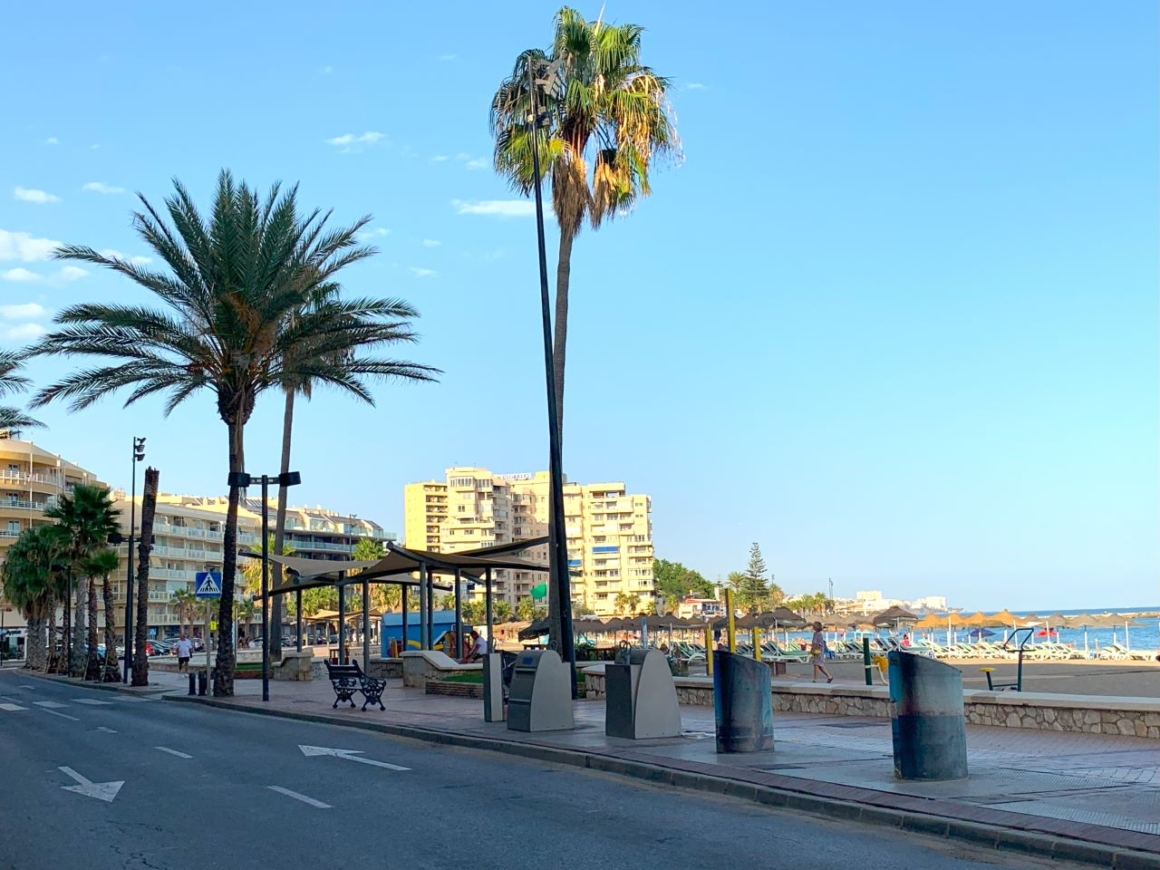
In this area of the promenade there is the perfect spot for pictures:
One block behind the beach we find the N-340 (known here as Av. Torreblanca). Here we have beautiful views of Torreblanca’s hills and houses.
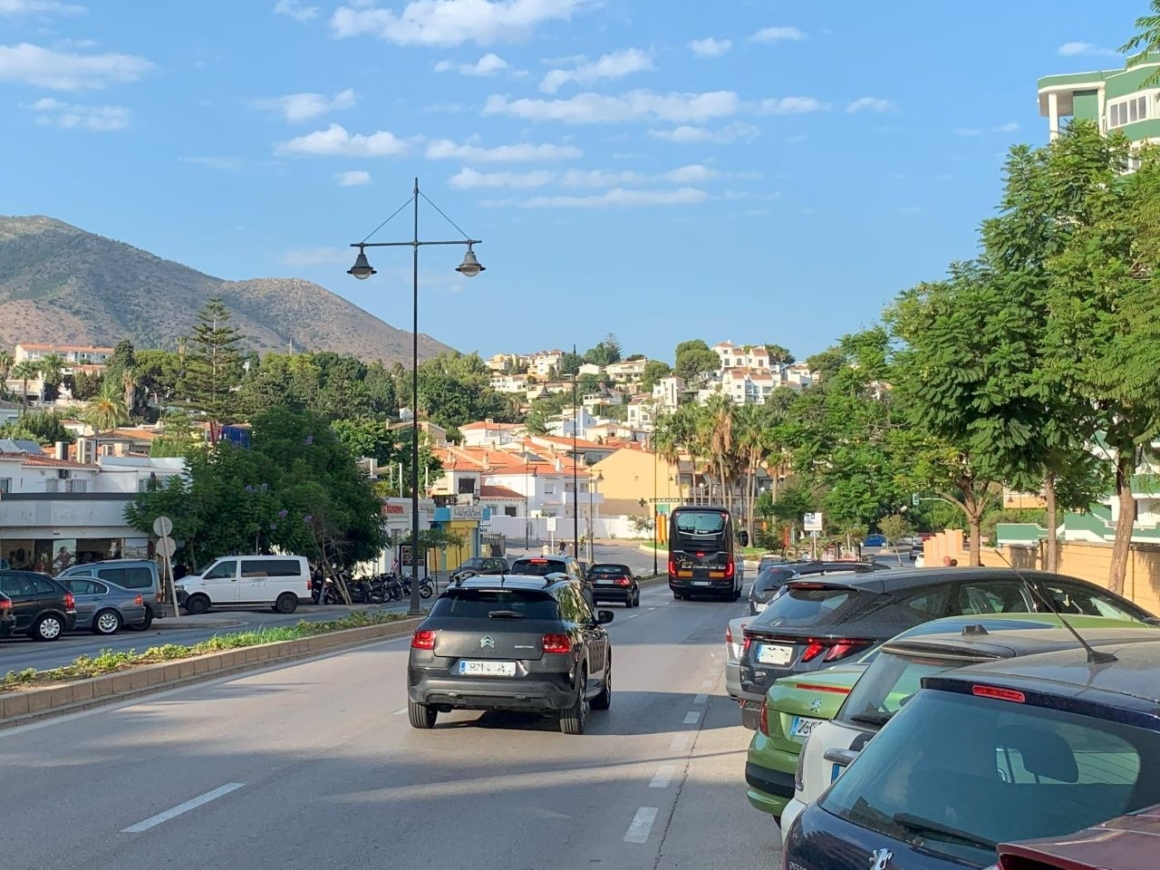
If we look inland, there are hotels and tall buildings mixed. It is hard to distinguish which is which; the one thing that stands out to me is that I always see people coming back from the beach in this area – carrying chairs, wearing flip flops, or not wearing shirts, among other telling signs – and I guess Google car experienced the same!!
This coastal area, Los Boliches beach and the Puerto Deportivo area have most of the hotels of Fuengirola, due to the proximity of the sea and the continuity of the promenade.
4 – Los Pacos
Remember when we mentioned that Fuengirola is not as flat as is often said? Well, here is an example. Los Pacos is a mostly residential area that, just as the also mostly residential Torreblanca and El Higuerón, is hilly.
Los pacos has mainly small buildings and townhomes, which preserves a bit of a small village atmosphere. But not (only) a small Spanish village… Los Pacos hosts the biggest Finnish community outside of Finland! It has its own Finnish school – the only one in Spain!
One of Los Pacos’ main streets is Avenida Finlandia (shown below, by Plaza Suomi – which means Finnish in… Finnish!)
5 – Los Boliches
Los Boliches is a nice, flat residential area with mostly medium and tall buildings and the kind of infrastructure that belongs in a residential area, such as supermarkets, schools and a health center. Due to its flatness and proximity to the beach, there are plenty of vacation rentals in the area as well; and due to the high populational density of the area (number of people per square meter), plenty of commerce flourishes here.
Los boliches is separated from our next location, Los Boliches Beach by the Avenida Nuestro Padre Jesus Cautivo and by the suspended train line, both which you see on the image below. In practice, though, these two areas are known as Los Boliches, and there isn’t much of a separation between them.
Los Boliches is cut in the middle by the A7, the highway of the Costa del Sol, and here, indeed, the difference between the two sides of the way is very noticeable: towards the sea it’s the residential Los Boliches we’ve seen up to now; towards the mountains, it is a vast empty land that is hard to understand, particularly when we take into consideration this area is so close to both the densest part of Mijas (Las Lagunas) and to the densest part of Fuengirola (Fuengirola Center). I bet it won’t stay like this for long.
Above: the desert area of Los Boliches, seen from Boulevard La Loma.
Los Boliches borders are all interesting. The west (far west? :P) is the desert area we just mentioned; in the northmost part there is the Finca del Secretario, a Roman site that has been discovered in 1987 (below) and which can be visited for free – though there isn’t really all that much to see there; if you are very interested in the Roman occupation of the South of Spain, though, it is a must. The Finca del Secretario can be seen from the train, if you are facing the mountainside – but as it is very small, if you blink you’ll miss it.
The south limit of Los Boliches is the Recinto Ferial, which we will talk about when we get to Fuengirola Center; and the East limit is more of a continuation: it is Los Boliches beach, which we’ll see next!
6 – Playa de los Boliches
Los Boliches and its beach (playa de Los Boliches) were once a fishing village and despite today’s growth, some of that time can still be perceived. Many of the original small houses are still in place; some have been growing in height and become buildings. Playa de Los Boliches seems to be growing both in popularity and in height.
Above: the yellow house is probably what the houses of fishing village of Los Boliches looked like; the houses to the left of the image have had floors added.
Los Boliches is now entirely integrated into Fuengirola. Many of the original houses have been converted to commerce, particularly along main streets, and the area holds a relaxed and easy-going atmosphere.

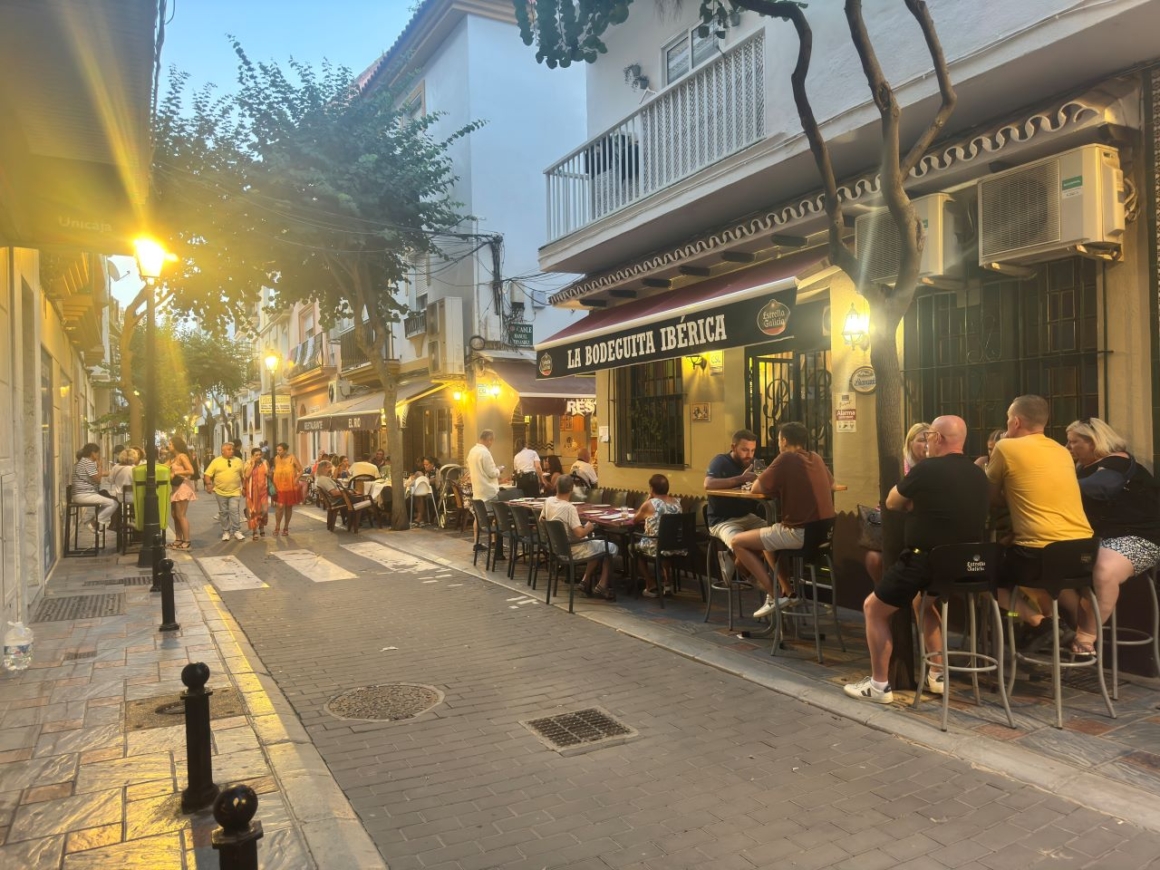
The Paseo and the beach are the high points of this area:
Dreamy, right?! When walking along the promenade, you’ll find a few of Fuengirola’s landmarks:
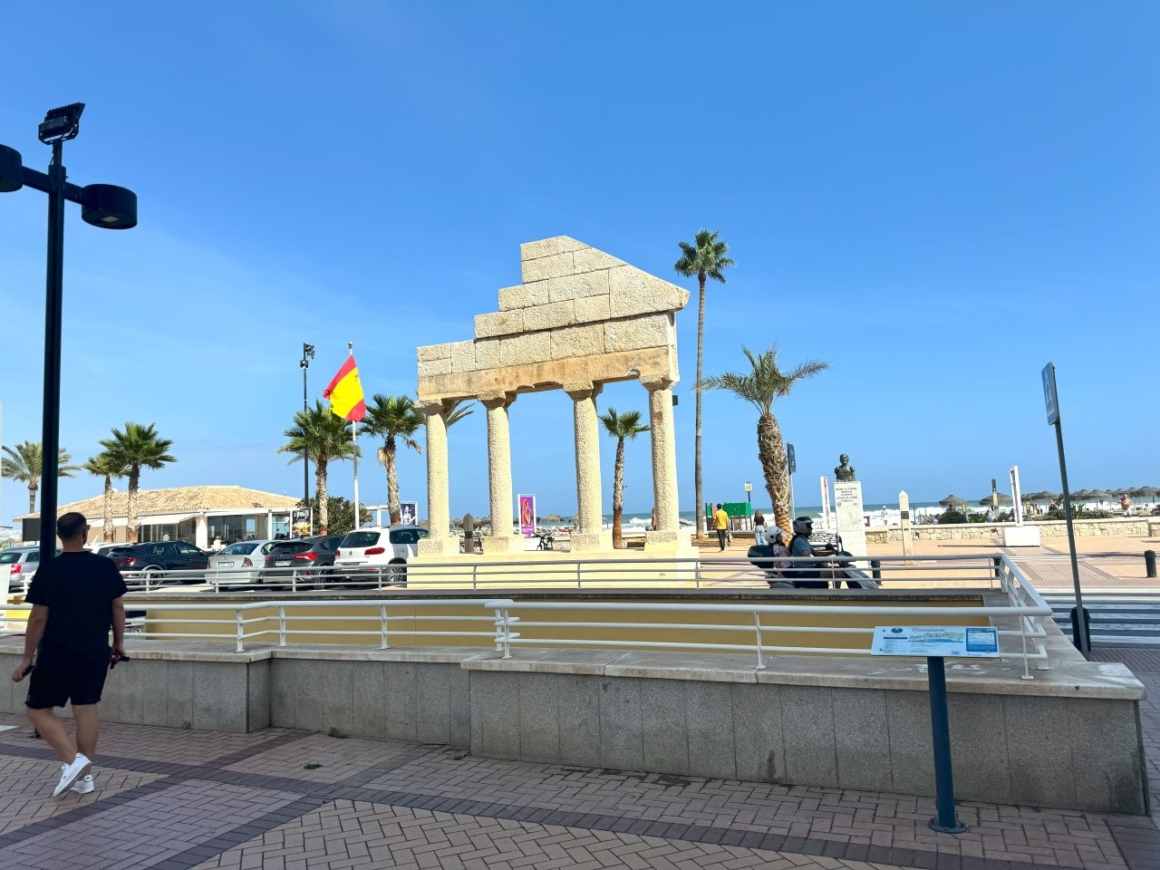

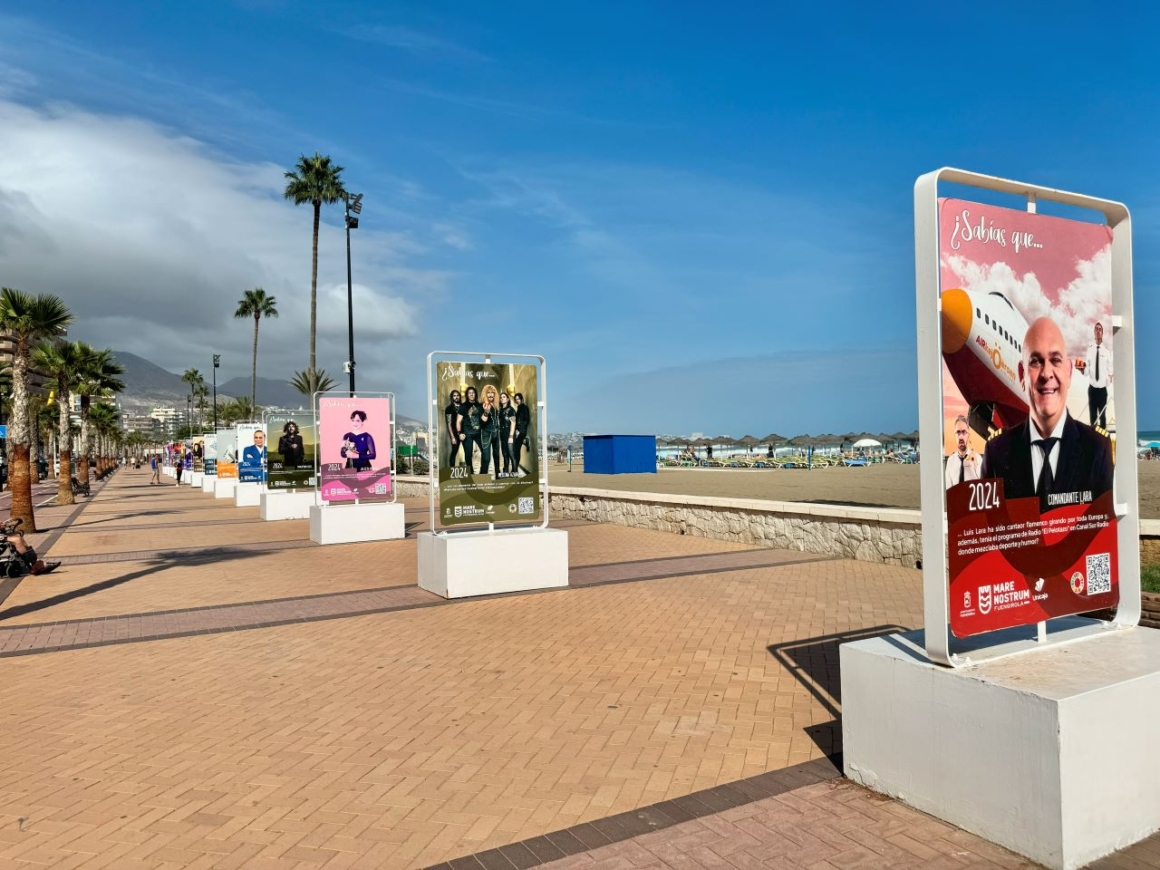
Above: Roman Columns, Monumento a la Peseta and the Marenostrum billboards
Right across the Roman Columns, there is Pedro Cuevas Square, which often holds events during the Veladilla de la Virgen del Carmen (Mid-July), Ferias del Rosario (in October) and Christmas, among other times.
The area of the beach of Los Boliches is one of the cultural hubs of the town. The main event in the area is the Veladilla de la Virgen del Carmen, a celebration in honor of the patroness of all sea people – sailors, fishermen – and also of Los Boliches. The day of Virgen del Carmen is July 16; the Veladilla, though, can last for a few days, much like a fair.
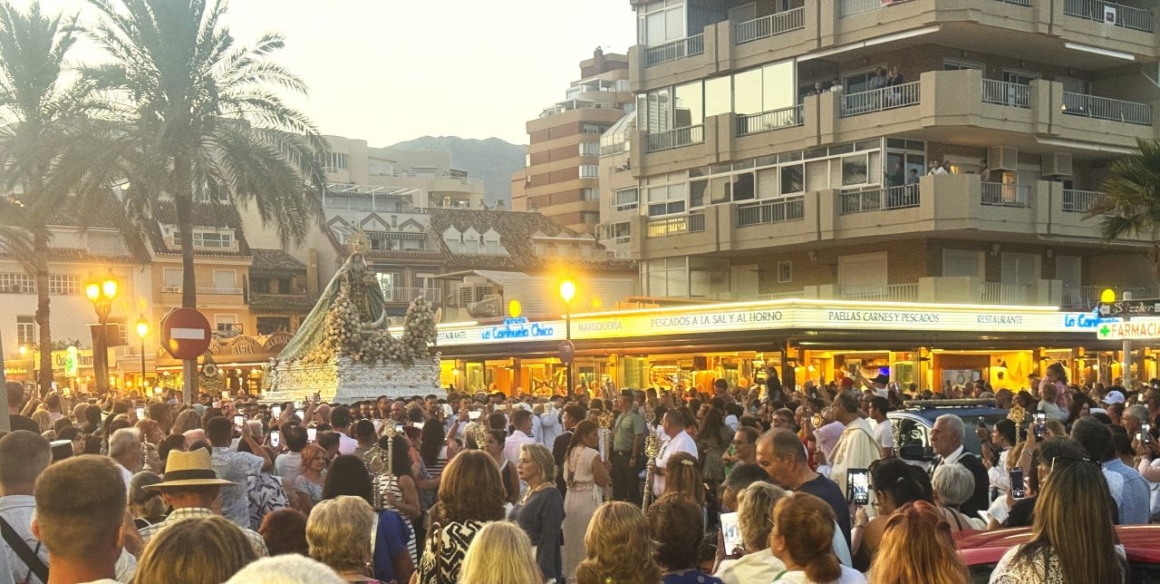
An important event of the Veladilla del Carmen is the procession, during which men dressed as sailors take the Statue of the Virgin to the sea. They enter the sea and carry the statue above the water!
Above: church of Virgen de la Virgen del Carmen; below, the patroness’ statue, both in the Playa de los Boliches.
In my opinion, Los Boliches beach is one of the best areas in the Costa del Sol, as it is one of the only that is at the same time lively, flat, close to the beach and to a train station (Los Boliches), making it a perfect place both to enjoy and to explore the other towns of the Costa del Sol. It comes as no surprise that it is a visitor’s favorite.
7 – Fuengirola Center
The center of Fuengirola is a quite dense neighborhood that extends all the way into Mijas. While walking, you may cross into Las Lagunas de Mijas without even noticing! Part of this seamless transition may relate to the fact that Fuengirola was actually part of Mijas until 1841.

You’ll see the arch shown on the image above at the Start of the Avenida de Mijas, very close to the Fuengirola Train Station; if you go through it, a few minutes walking get you to Mijas:
The area of Fuengirola Center closest to Mijas, by the Avenida de Mijas, is known as El Boquetillo. This area is undergoing some revitalization initiatives; one of them being the recent (2023) painting of murals in Calle La Paz, which have become a local attraction:
If you “walk” around on the two Google maps above, you may notice some narrow streets have sequences of tall buildings side by side, sidewalks, roads and not much else – no free spaces; the few vegetation are the trees on the sidewalks. It can get a bit claustrophobic, as the tall buildings on both sides of the road, so close to each other, leave little area to see the sky. The high volume of cars is another consequence of this high building density.
The good side of the high populational density is that you can get a bit of a big city in an otherwise, medium-sized town: lots of people, commerce, restaurants, hotels and nightlife, not to mention the good offer of public transportation; the bad side, in my opinion, is precisely the lack of green – there is no large park, like you’d find in Benalmadena (La Paloma) or Torremolinos (La Batería), and not much in terms of open space in Fuengirola Center.
There are a few playgrounds, though, spread through the area. The one below is one of them:
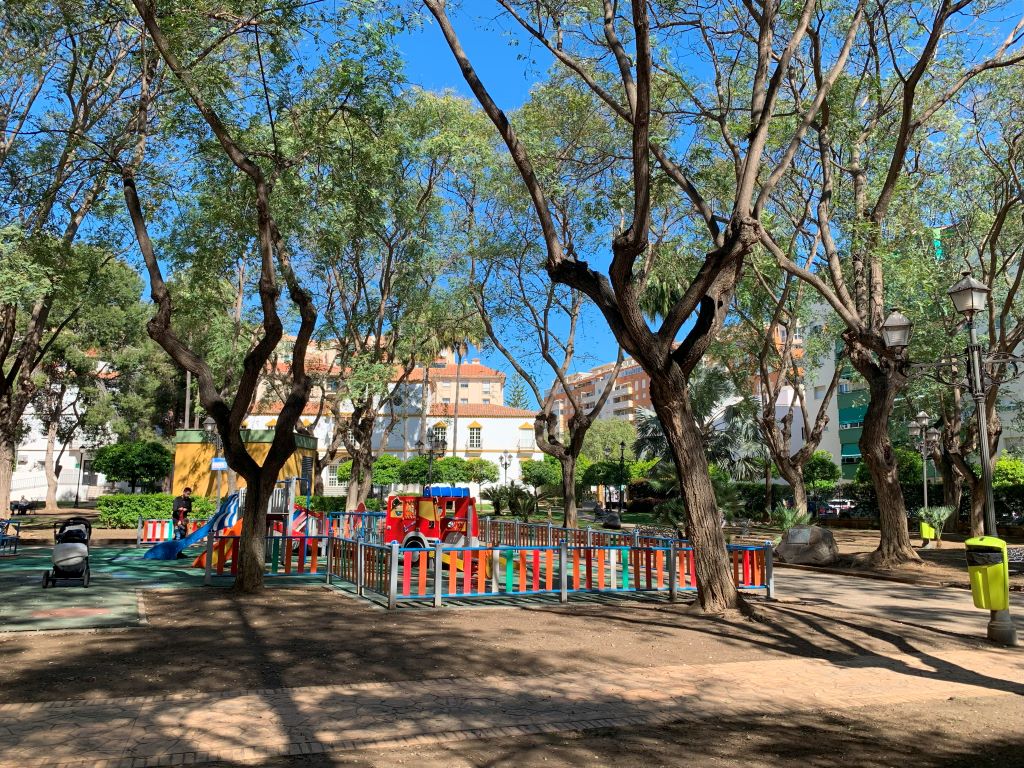
The main green area in Fuengirola is the Bioparc Fuengirola, a zoo in the city center!
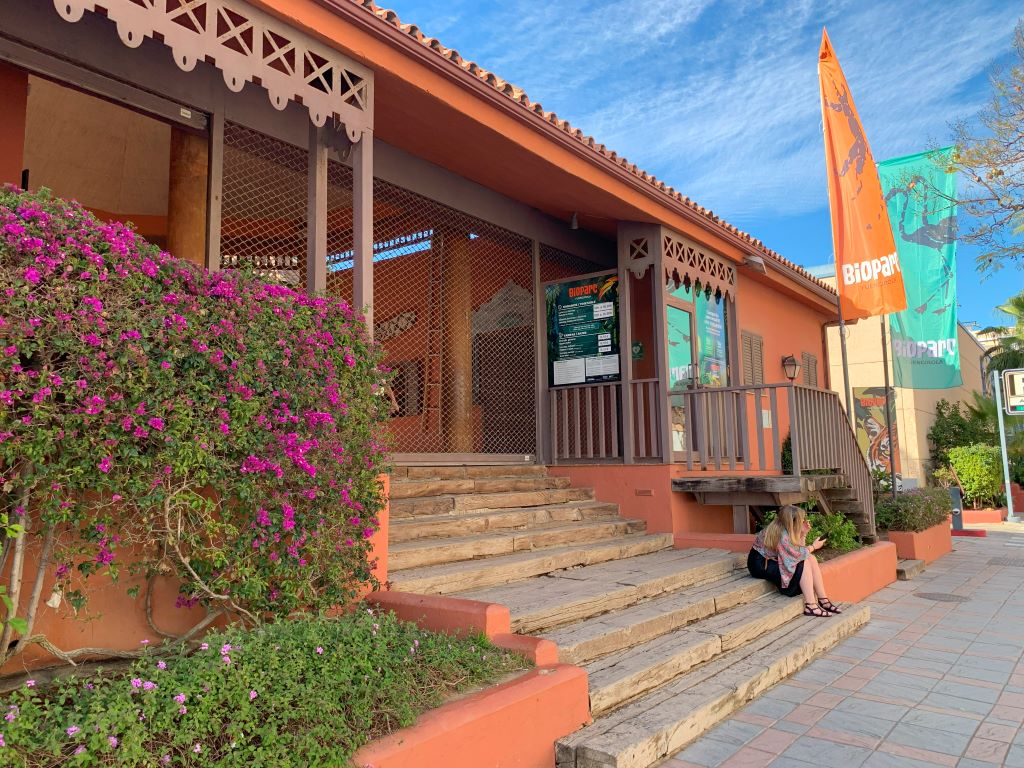
And very close to the Bioparc, there is the small Parque del Sol.
The part of Fuengirola Center closer to Los Boliches and to the Recinto Ferial is completely different from El Boquetillo. This area has – on average – larger spaces between buildings, more squares, more parking spaces and larger sidewalks, where cafes can spread some tables without blocking the passersby. It could be a bit greener in my opinion, though, but it already has more than in the denser area of El Boquetillo.
And since we are here, let’s see a bit of the Recinto Ferial, where several events happen throughout the year. The main ones are the fantastic Feria de los Países, in the end of April or beginning of May, and the Feria del Rosario, in October. True that events of this last one take place in other areas of the town as well, but the Recinto Ferial is the place that tends to concentrate most of the action. Fuengirola’s large fairground below:
The houses shown above host different activities or groups during the Ferias. During the Feria Internacional de los Paises (FIP), each one of them houses a different country. The area of the fairground that has no houses is usually used as a parking lot, but is taken by a funfair and a street market during the ferias. A few images of the FIP 2024 below:
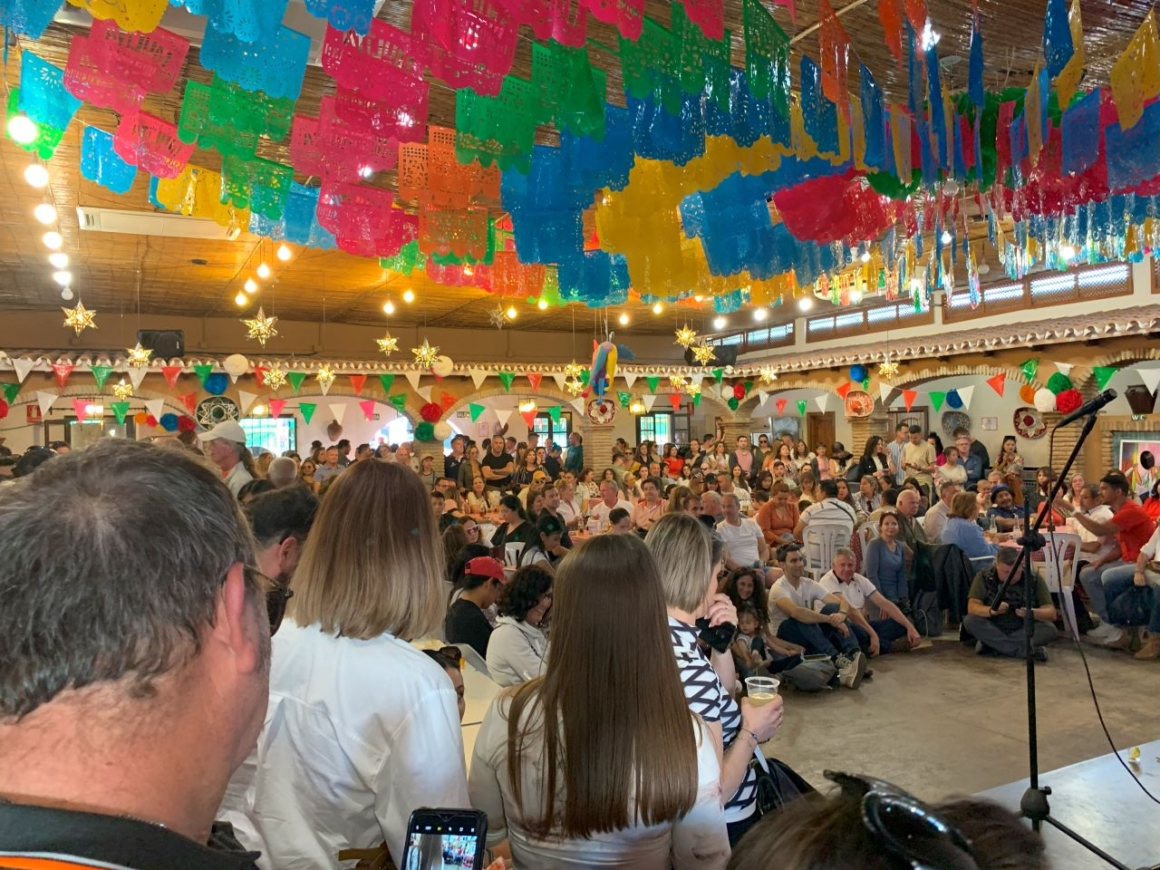
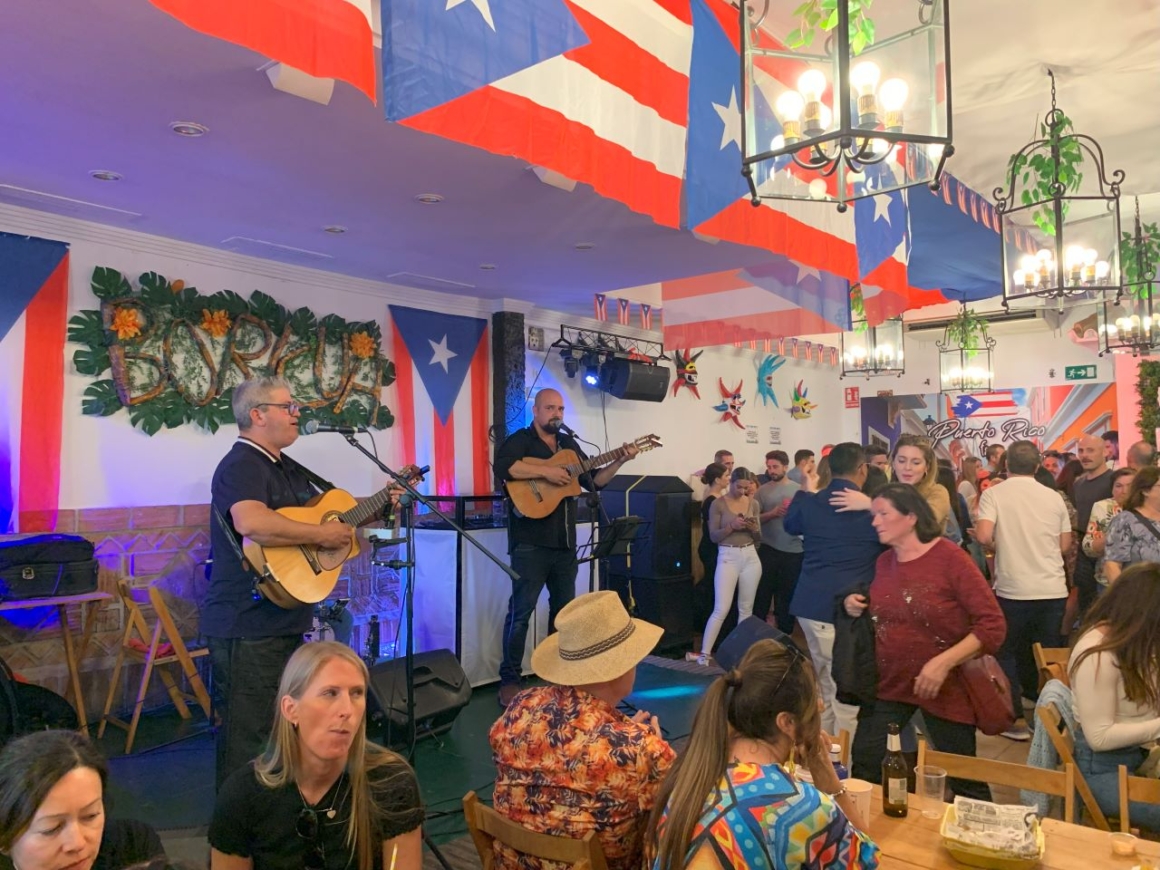
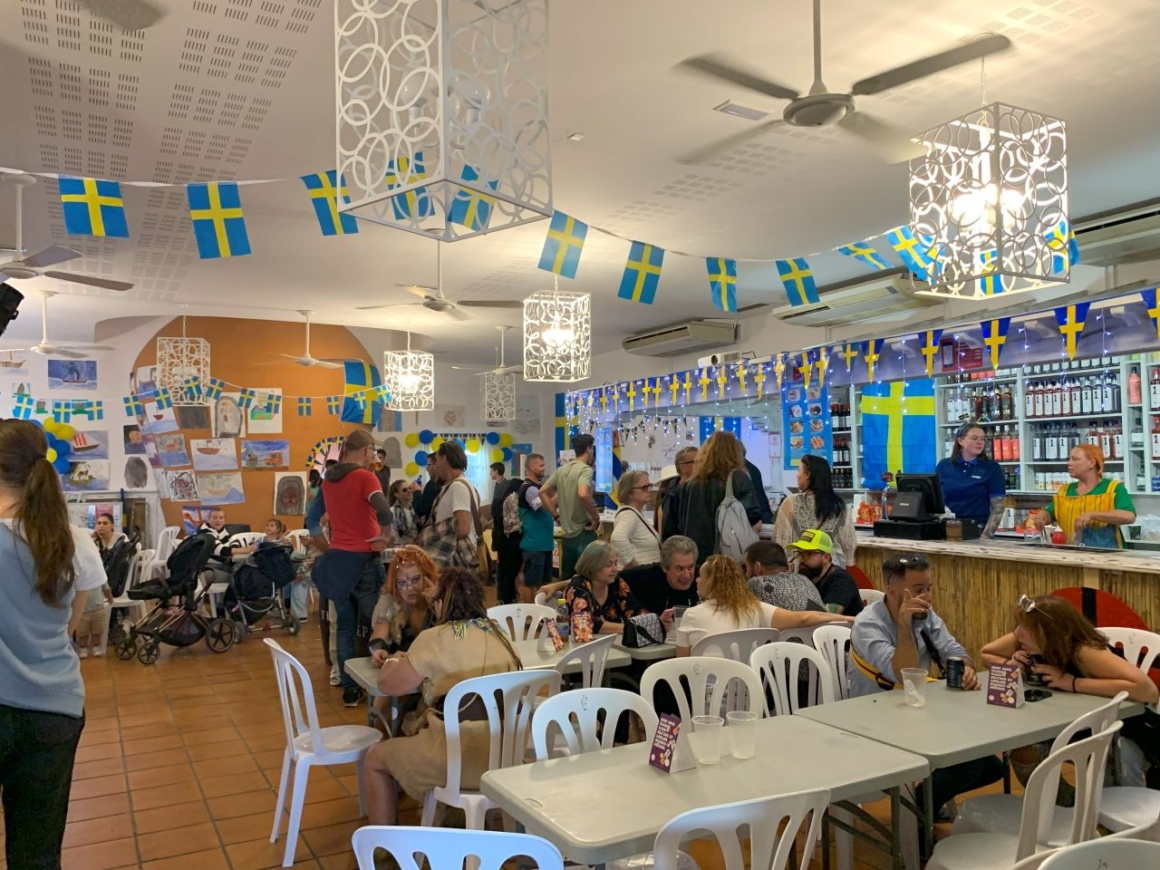

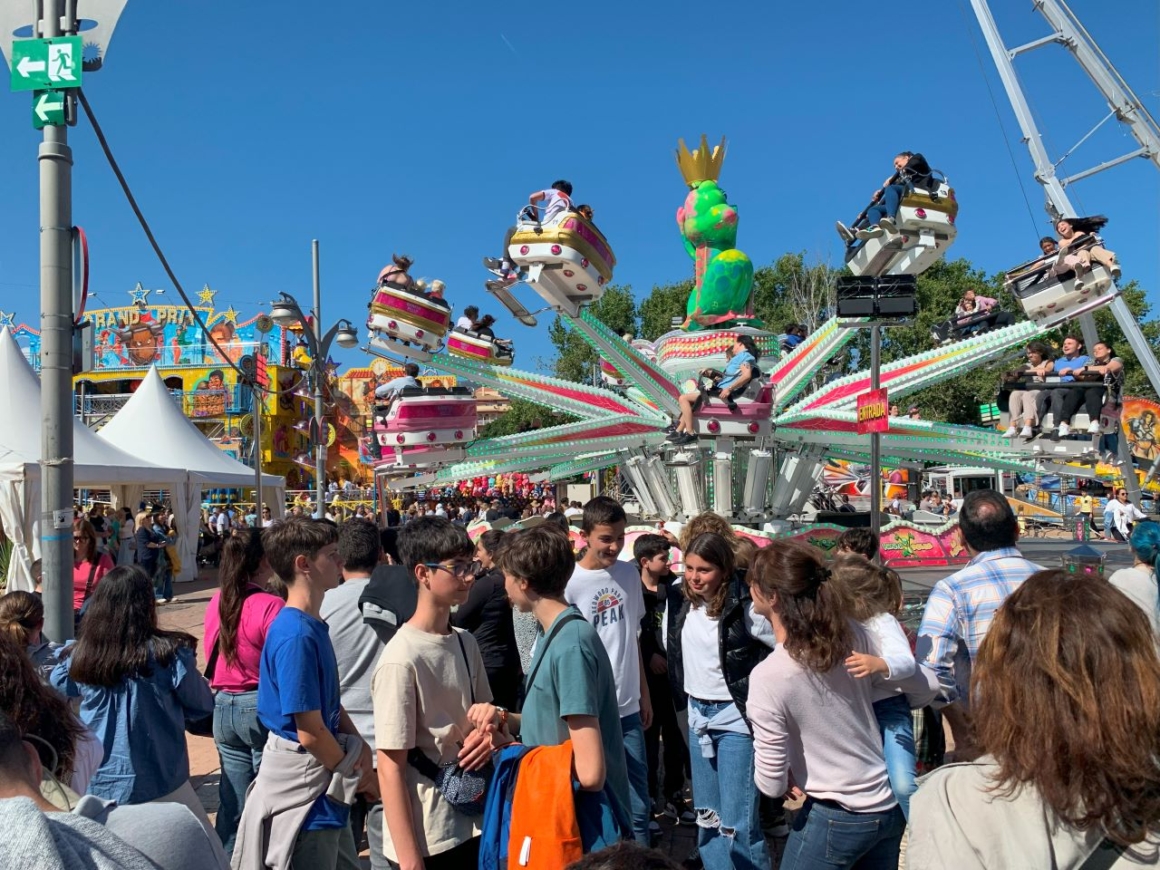
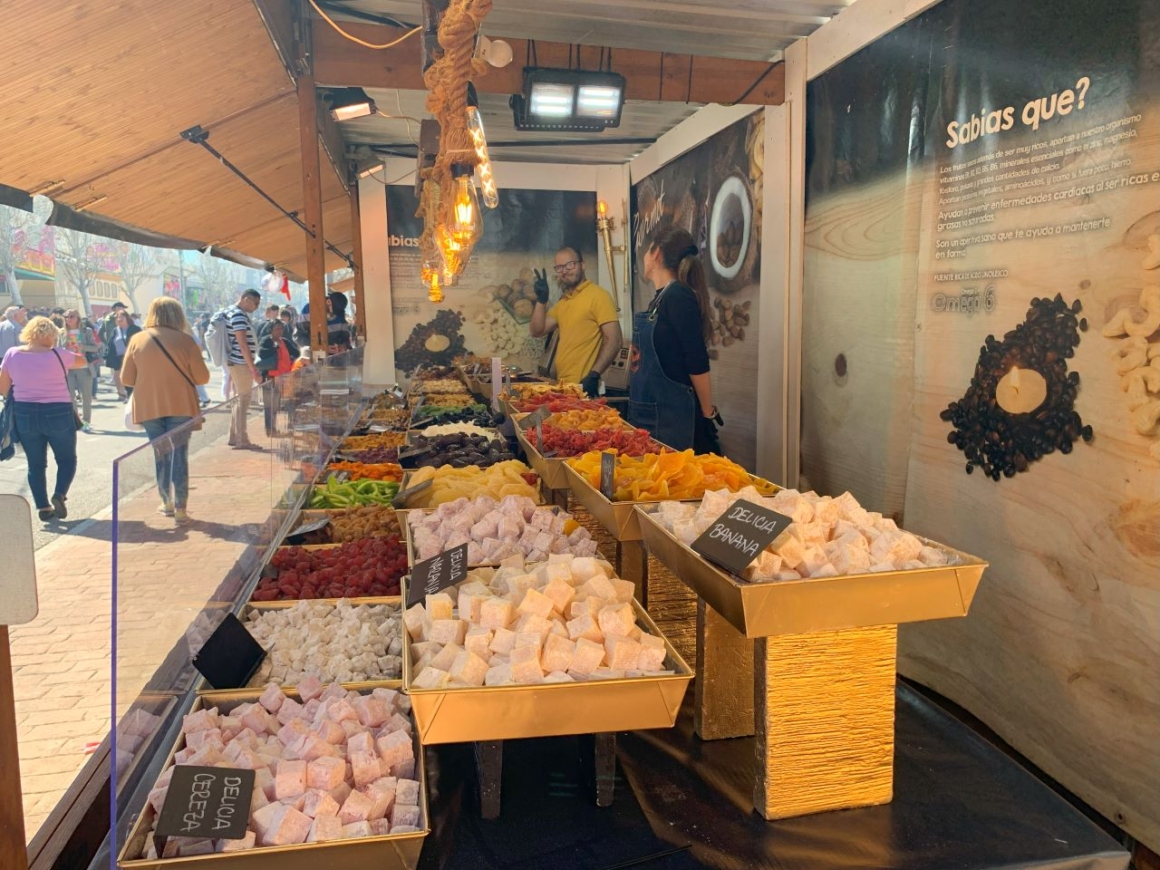
The street that separates Fuengirola Center from the Puerto Deportivo is one of the main streets of Fuengirola. It goes changing name along the way, but it is one straight line, and it has many interesting points on both sides. To the Funegirola center side, starting from the border with Los Boliches, we have the entrance to the Recinto Ferial (shown above) in the Avenida Nuestro Padre Jesús Cautivo; then the Fuengirola Train Station in Paseo Jesús Santos Rein; and the Municipal Library, the Multicines Alfil – cinema! -, the Bioparc and the Plaza de Toros all one after another in Calle Camilo José Cela.
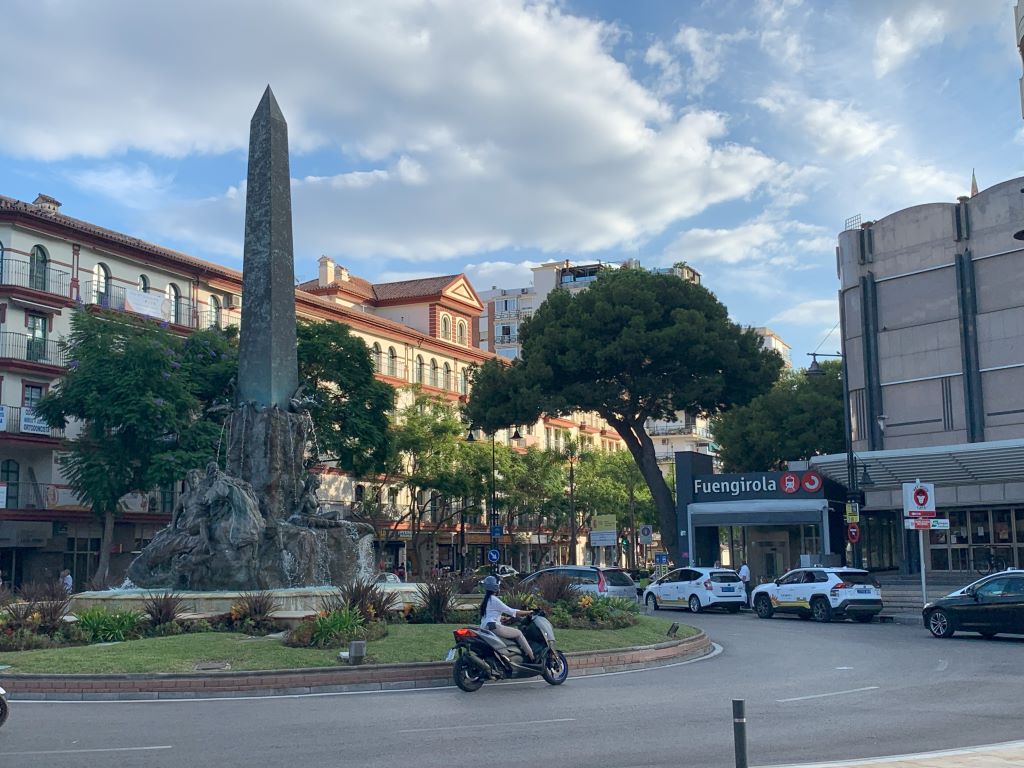
8 – Puerto Deportivo
The other side of that multi-named main street is also quite interesting. “Walk” along Calle Camilo José Cela below to see the Ayuntamiento de Fuengirola and the Museo de Historia de la Ciudad (City’s History Museum) on the Puerto Deportivo side, as well as the building we just mentioned on the Fuengirola Center side.
The Museo’s facade is cuter nowadays than when Google went there. 🙂
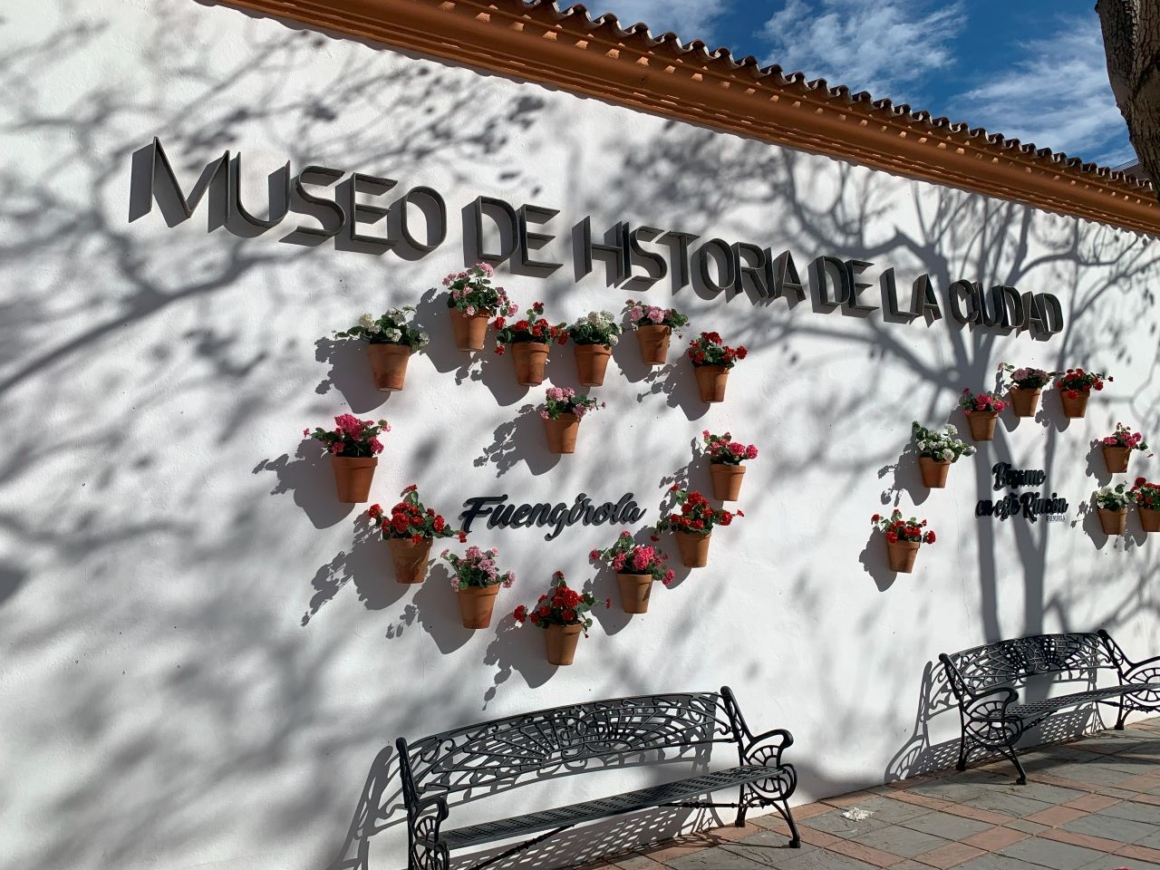

The Museo, also known simply as Museo de la Ciudad, is hosting an exposition called ‘Barbie Cinema and Fashion’ from September 13, 2024, to October 13, 2024! Pro tip: when in Fuengirola, it is always worth checking what is going on in both the Museo and in the Casa de la Cultura, a bit ahead in the same street – here called Avenida Juan Gomez Juanito.
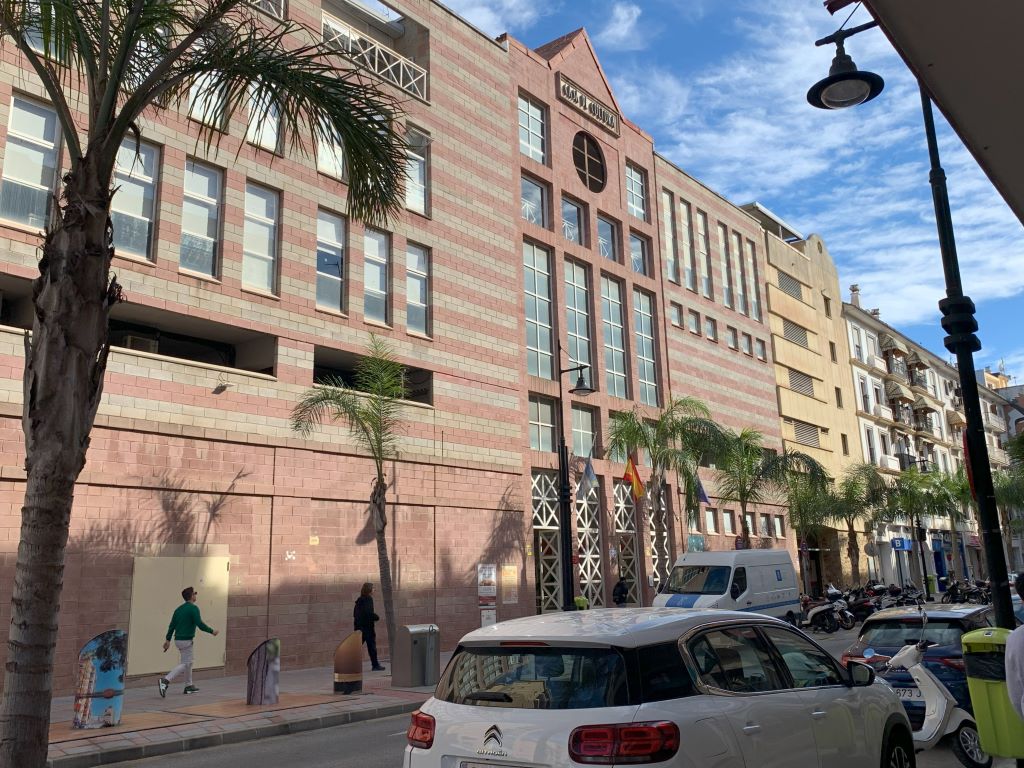
Talking about very interesting places, we can’t forget to mention both the Plaza de España and the Parque de España, right behind the Museo and the Ayuntamiento. This area always has something going on during Ferias, Christmas, Halloween, Carnival… basically, if the event has some activity geared towards kids, that’s where it will happen. It is also a nice playground to take the kids to play while in Fuengirola.
And a few pictures:
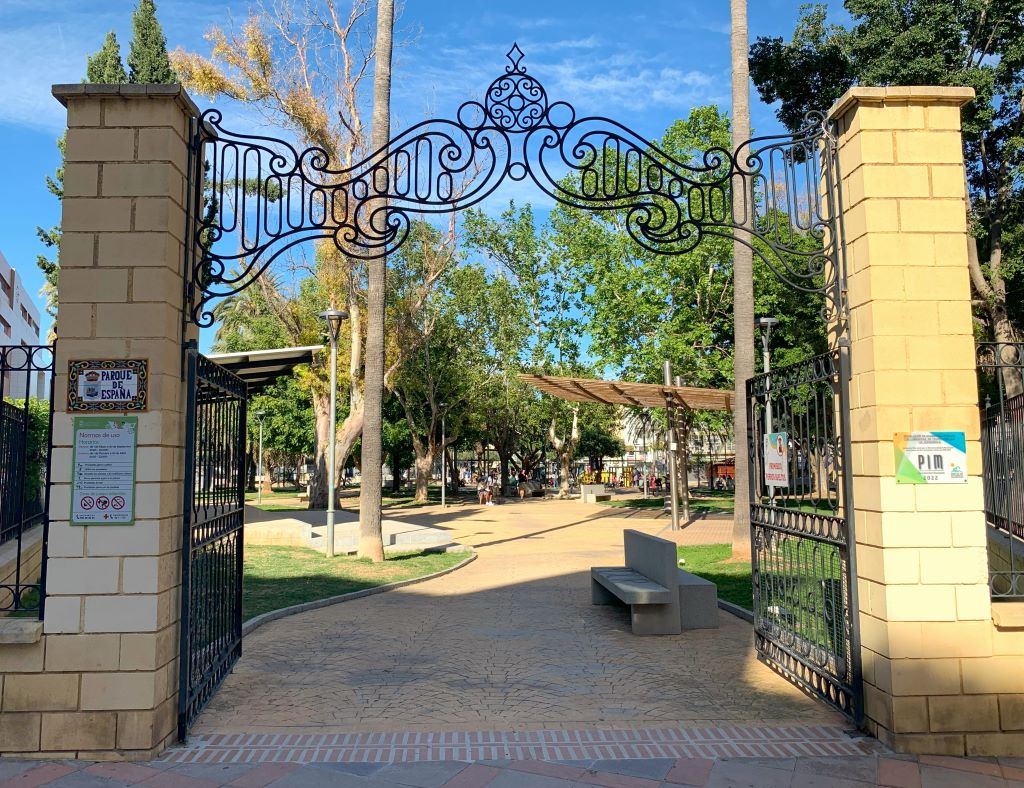
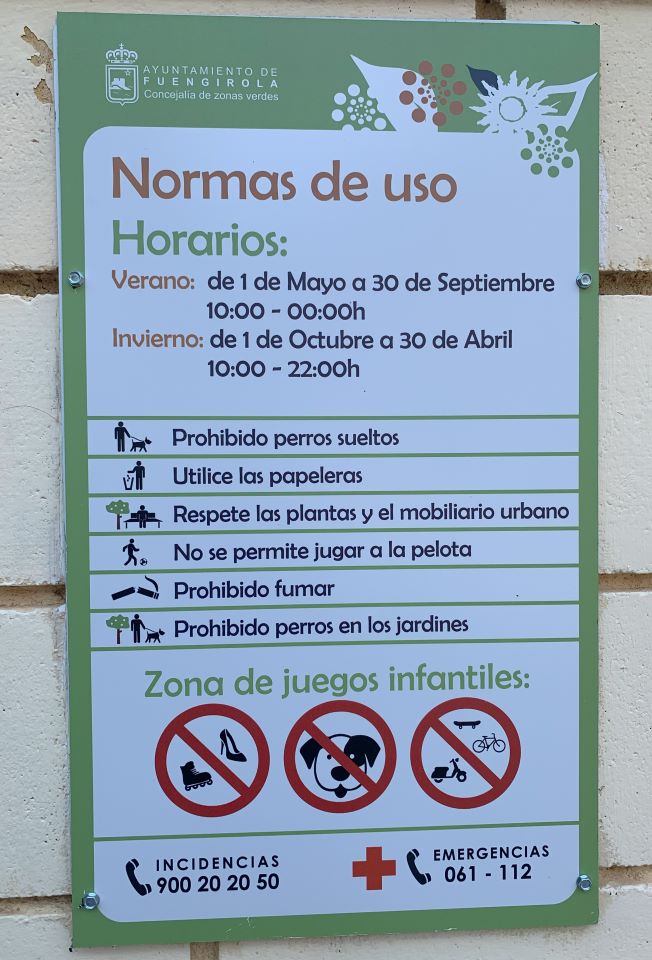
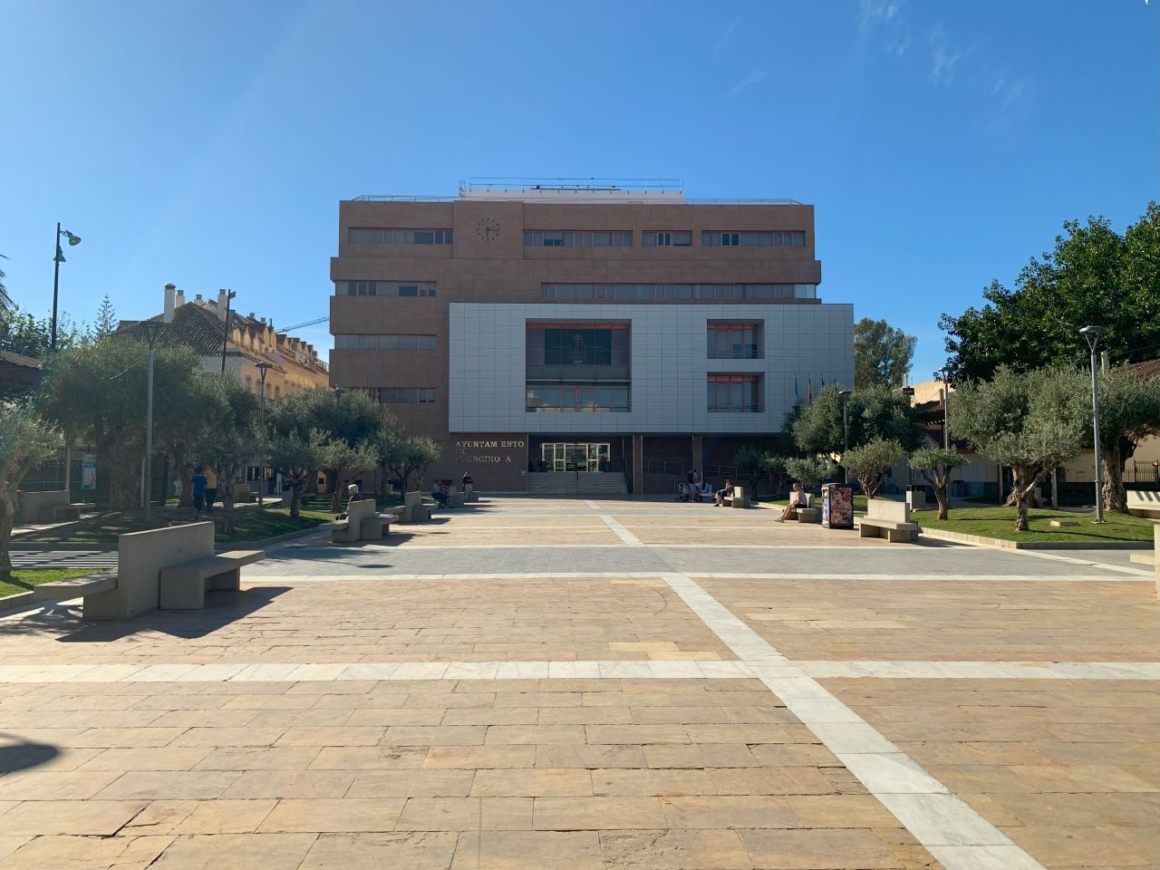
Still on the inland part of the Puerto Deportivo area, named after Fuengirola’s harbor, we find the Plaza Reyes de España – a tribute to the Catholic kings of the time when Spain was reconquered from the Moors – and the Plaza de la Constitución, where the Church of Our Lady of the Rosary (Parroquia de Nuestra Señora del Rosario) is. Both places tend to host events during the Ferias and other festive occasions, such as the Christmas Market (in my opinion, Fuengirola has the best Christmas Market of the Costa).

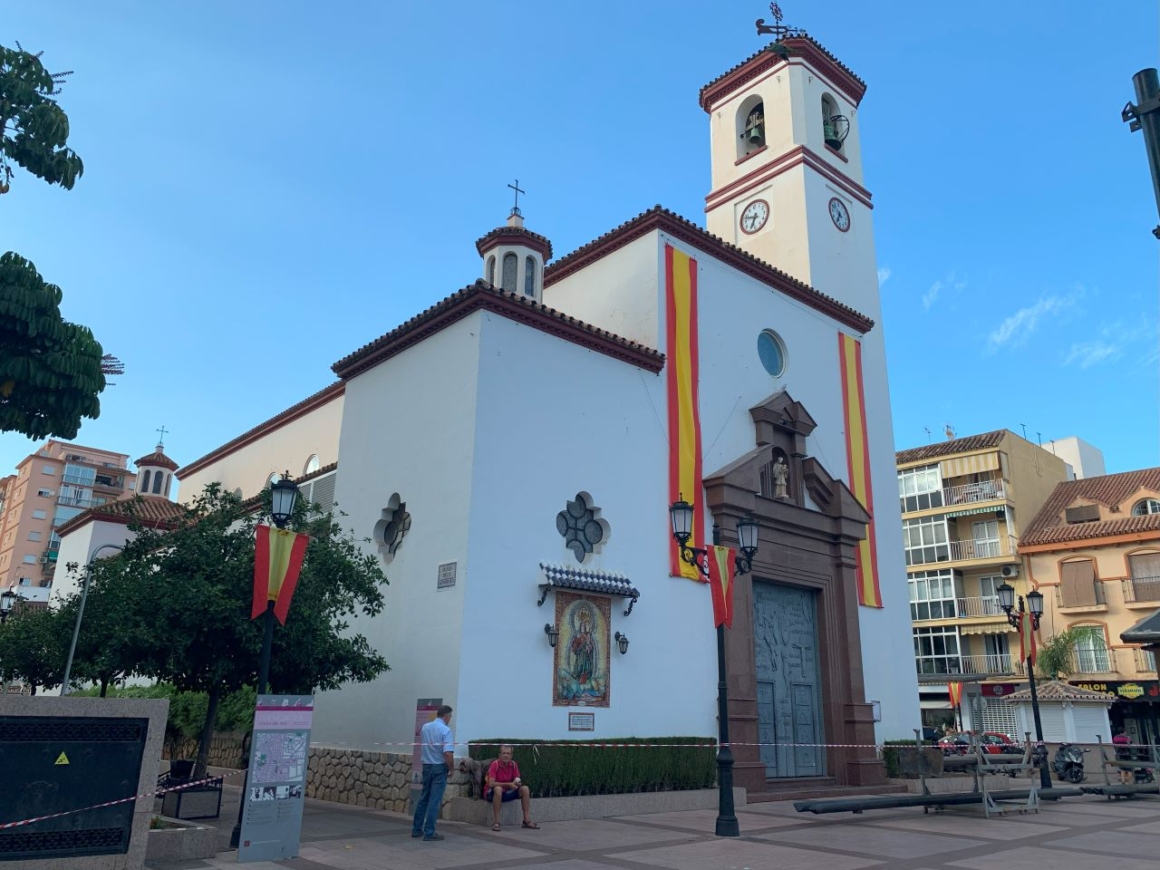

And all that before getting to the coastal part of the harbor area!
By the shore, close to the border with Los Boliches, on the T shaped breakwater, we find the iconic heart of Fuengirola:

The area around this breakwater can have stronger waves than most of Fuengirola, which makes it a surfer’s favorite. Despite that, it is not recommendable to swim here, because of the rocks along the breakwater itself and the harbor, which is not far. On days when the red flag is up, it is even forbiden to enter the water; still, people do it…
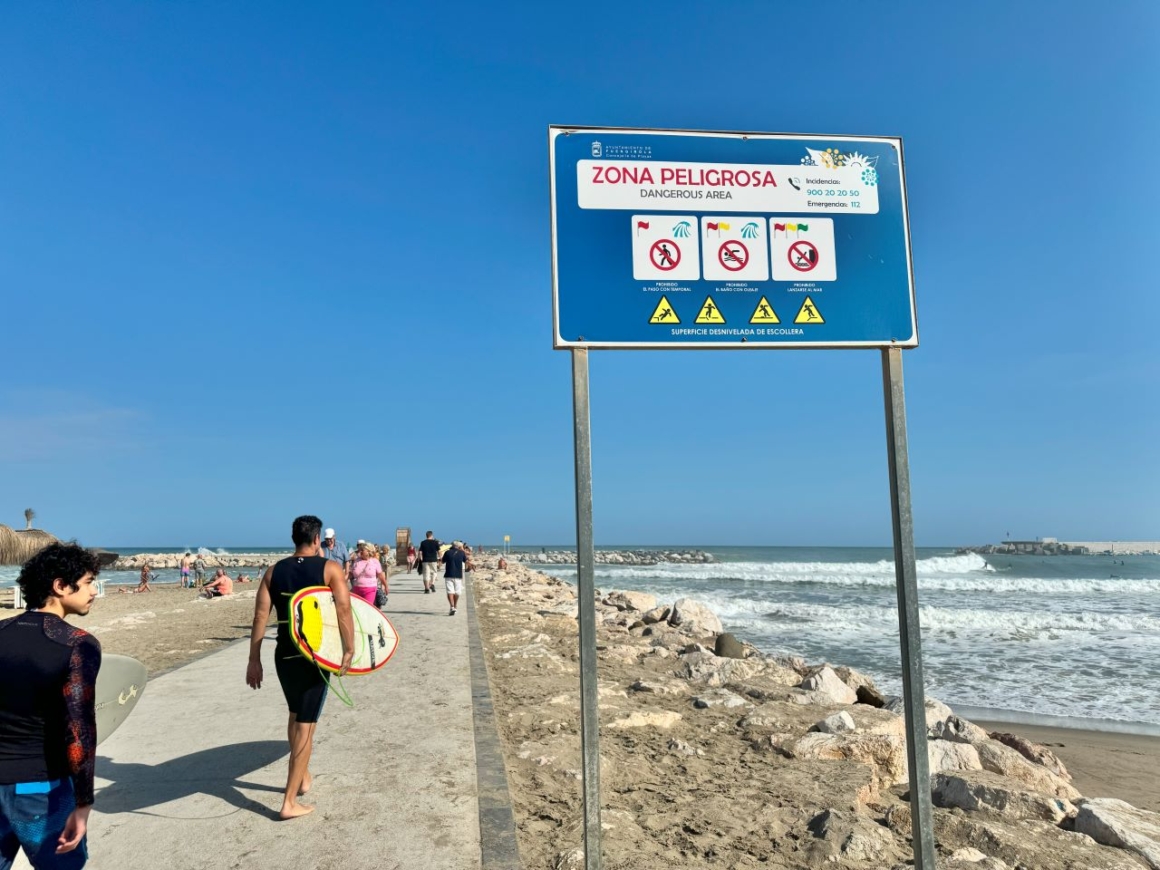
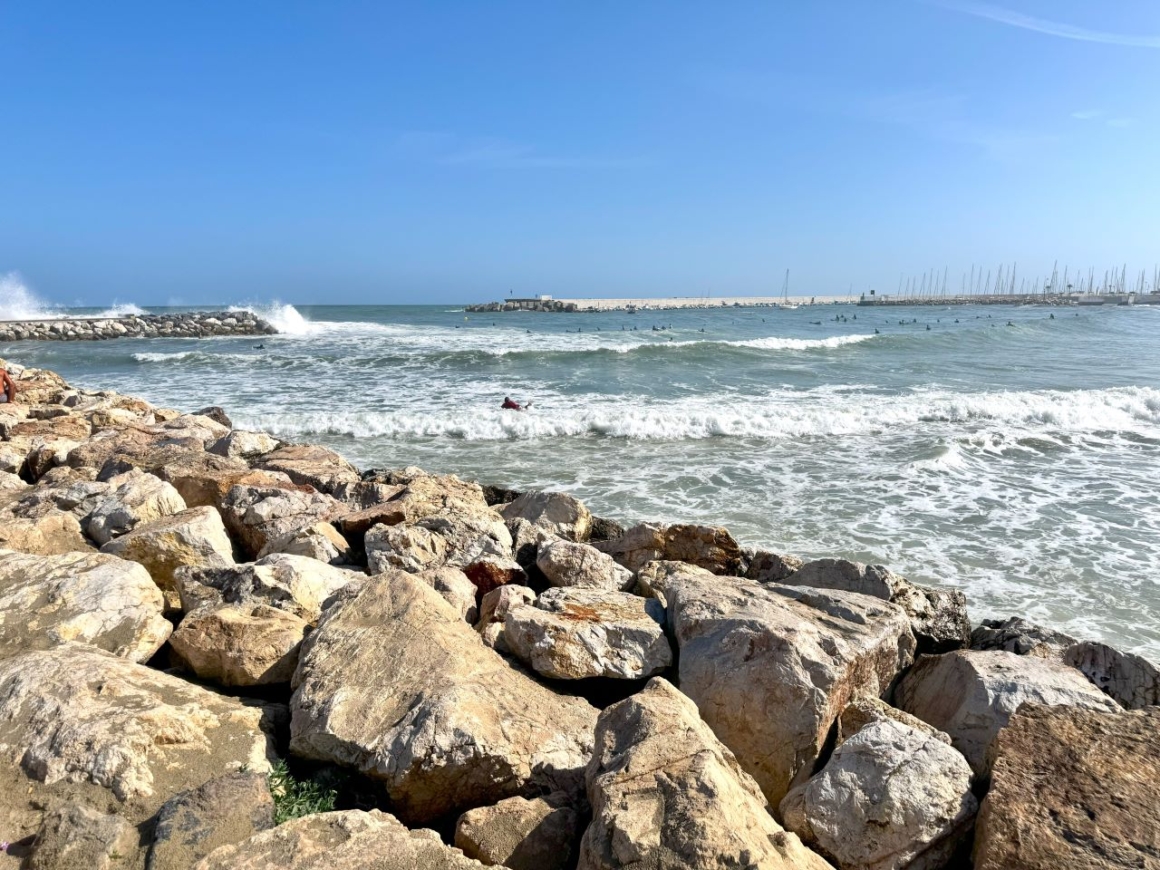
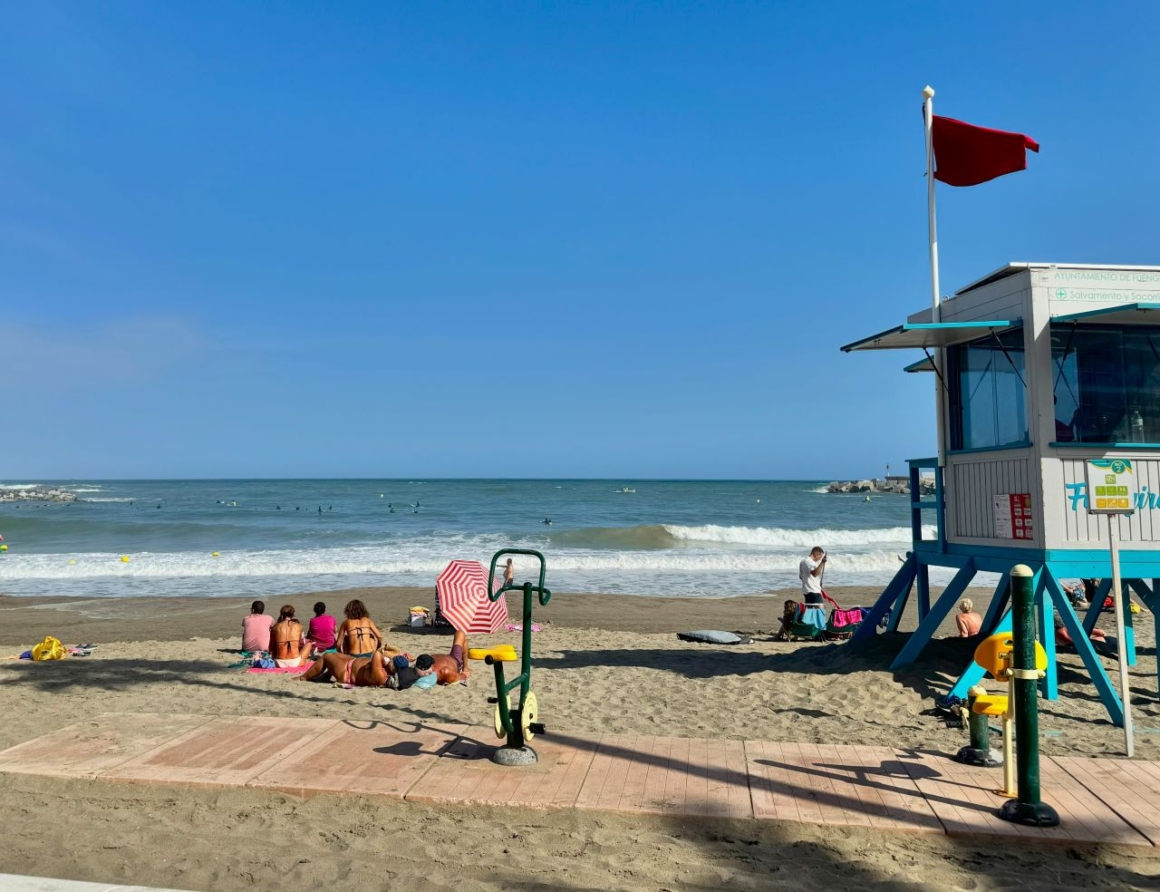
Right by the harbor is Sould Park, an amusement park ideal for small kids (mainly up to 7 years old, in my opinion, though bigger kids may enjoy it too).
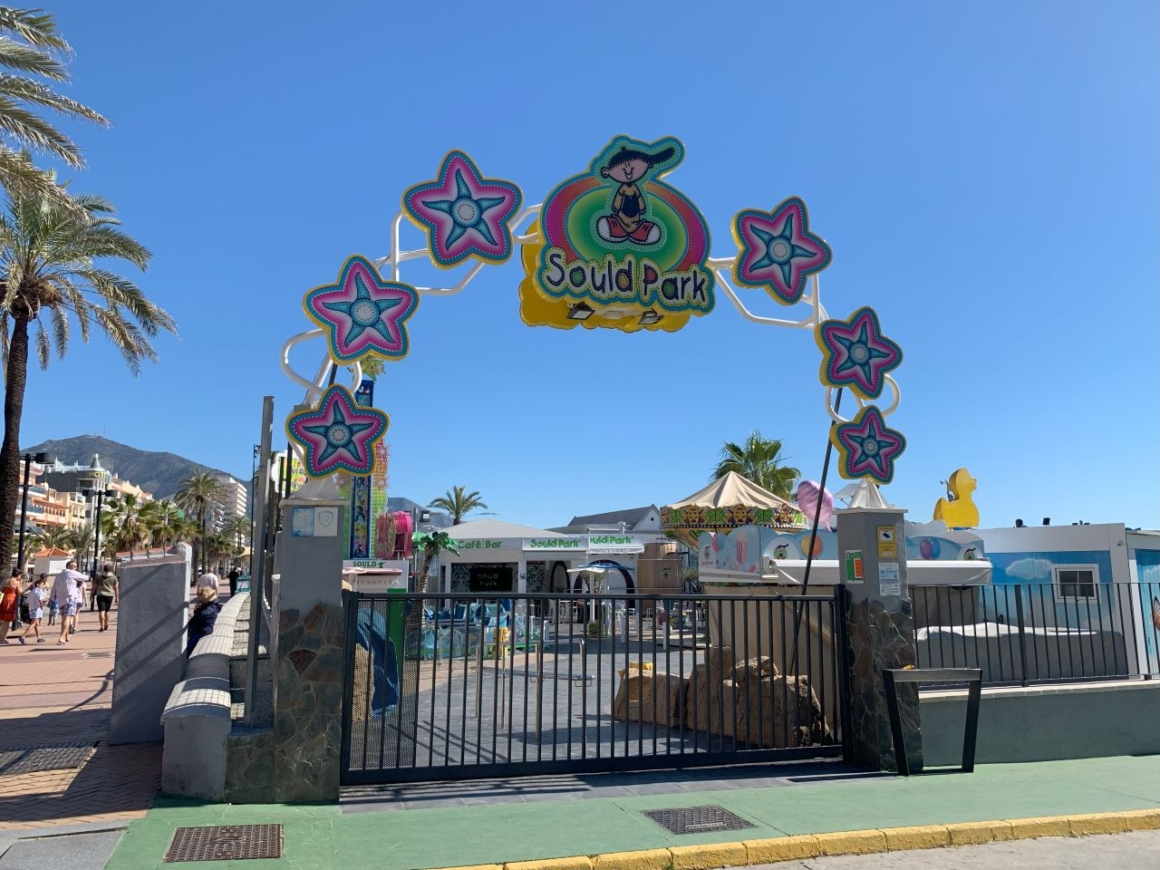
Below, a bit of the harbor and its promenade:
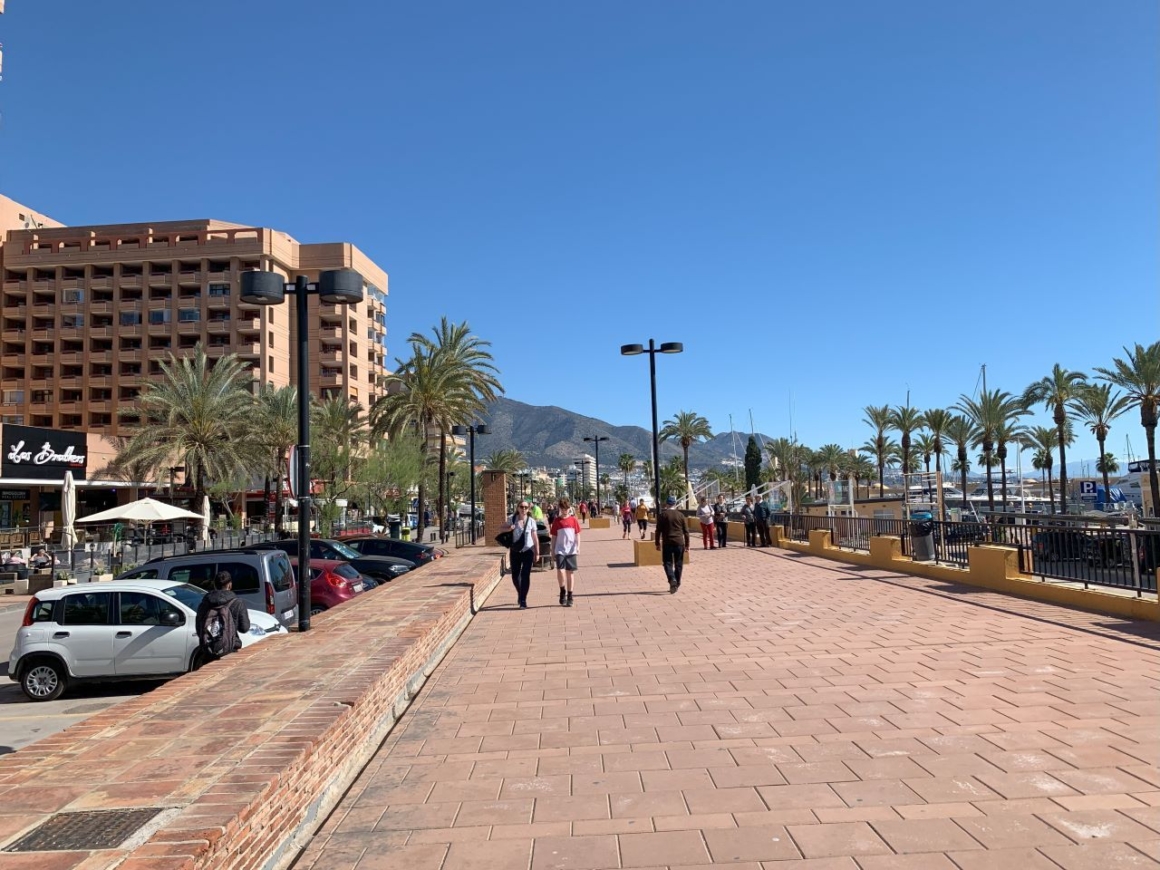
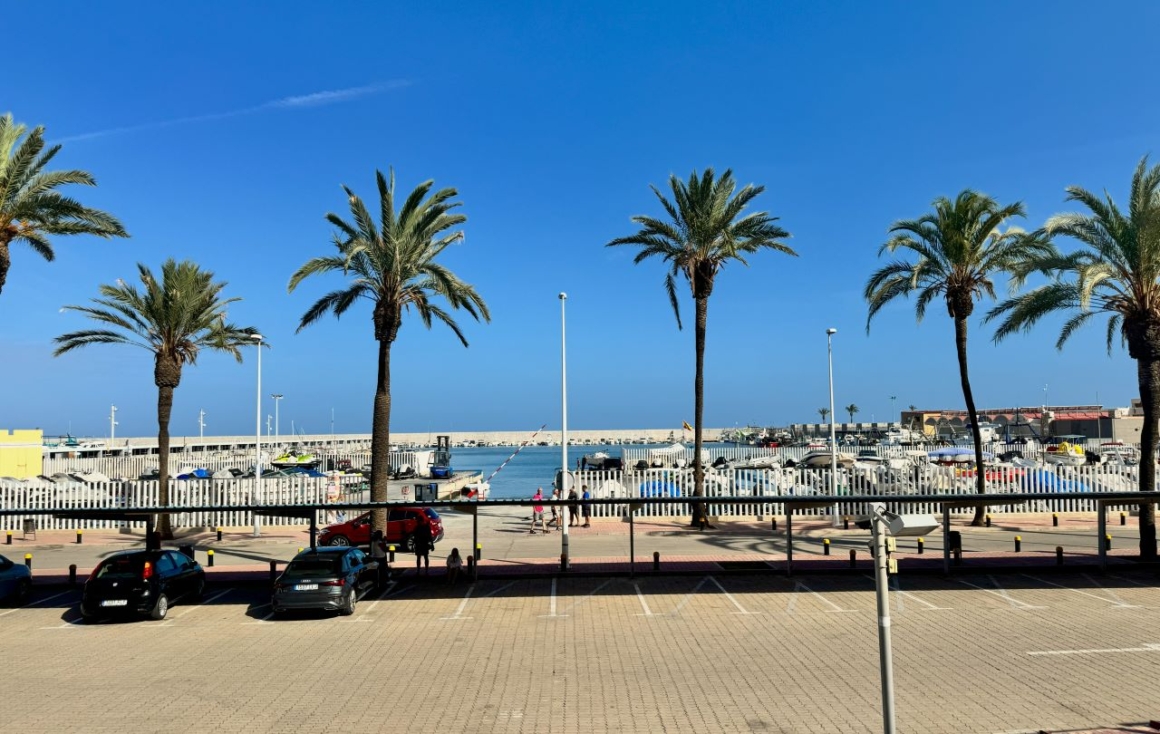
Two sculptures in the area: Mediterranea and the Hand. There are two hand-shaped sculptures in Fuengirola; a left hand on Los Boliches Beach and the right hand pictured below, in the Puerto Deportivo.

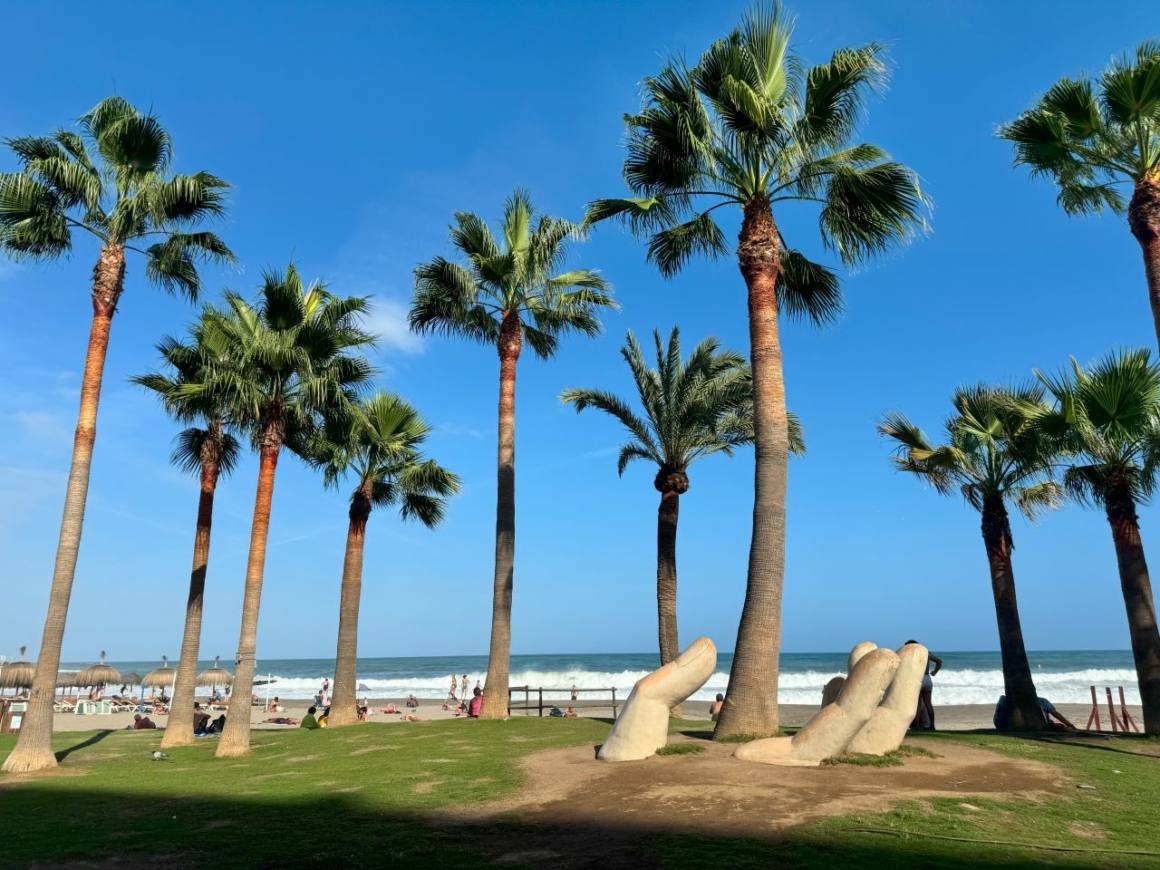
Continuing on the coast, we reach our last neighborhood: Sohail
9 – Sohail
Sohail is a residential and commercial area of Fuengirola, with buildings, townhomes and independent houses. It is also a zone of monumental landmarks, and the area where the promenade reaches a ‘Wow!’ factor, when we first see both the Armada bridge and Sohail Castle, plus the sea and Fuengirola river.
The first highlight of Sohail is the Armada Bridge:
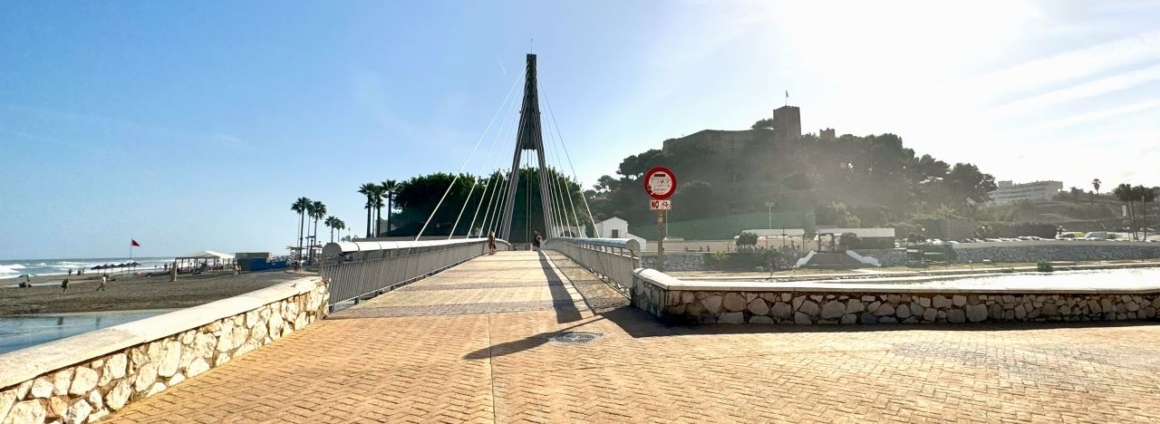
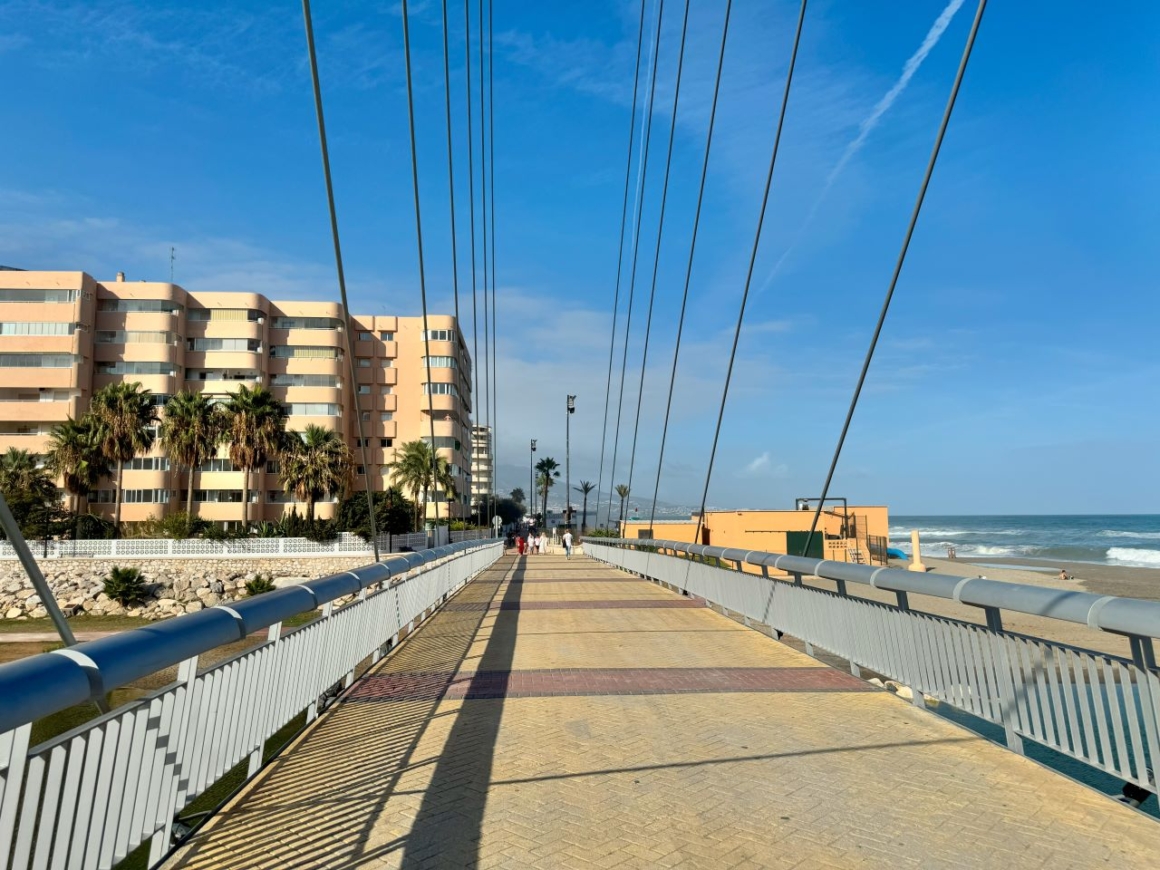
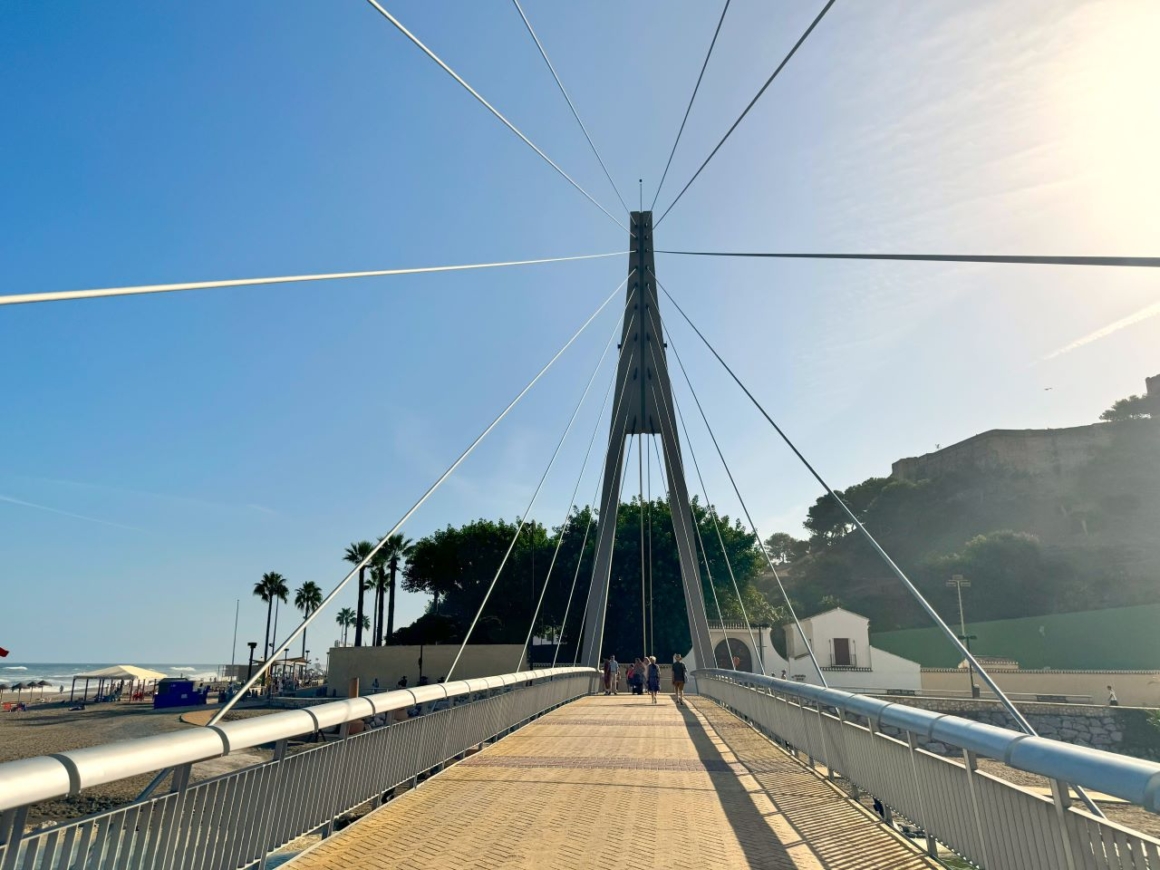
Above, a few angles of the beautiful and imposing Armada bridge. Below, the point where Fuengirola River meets the sea. You can see the shadow of the bridge on the river. 😉
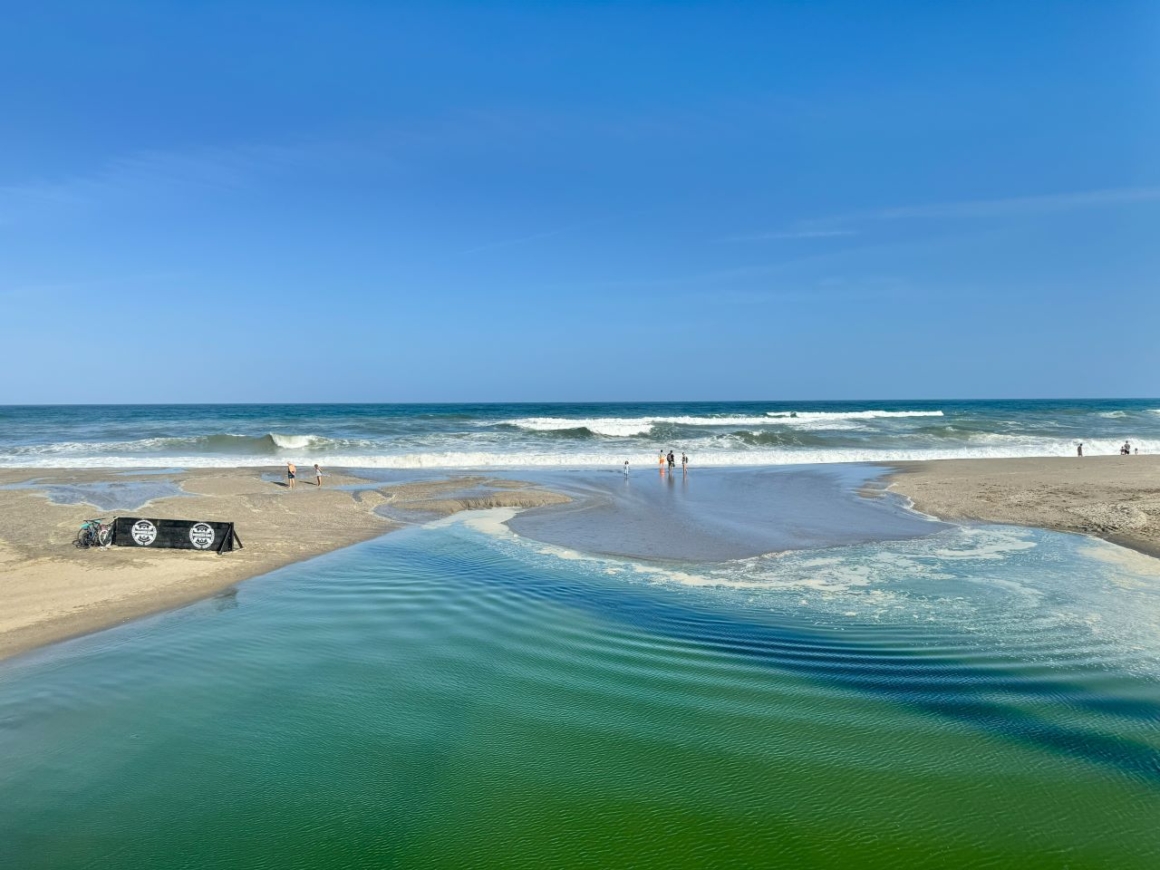
Sohail Castle is surrounded by a park, but it is not always open. If you want to visit either the Castle or the park, it is worth checking Turismo Fuengirola for opening times and dates.
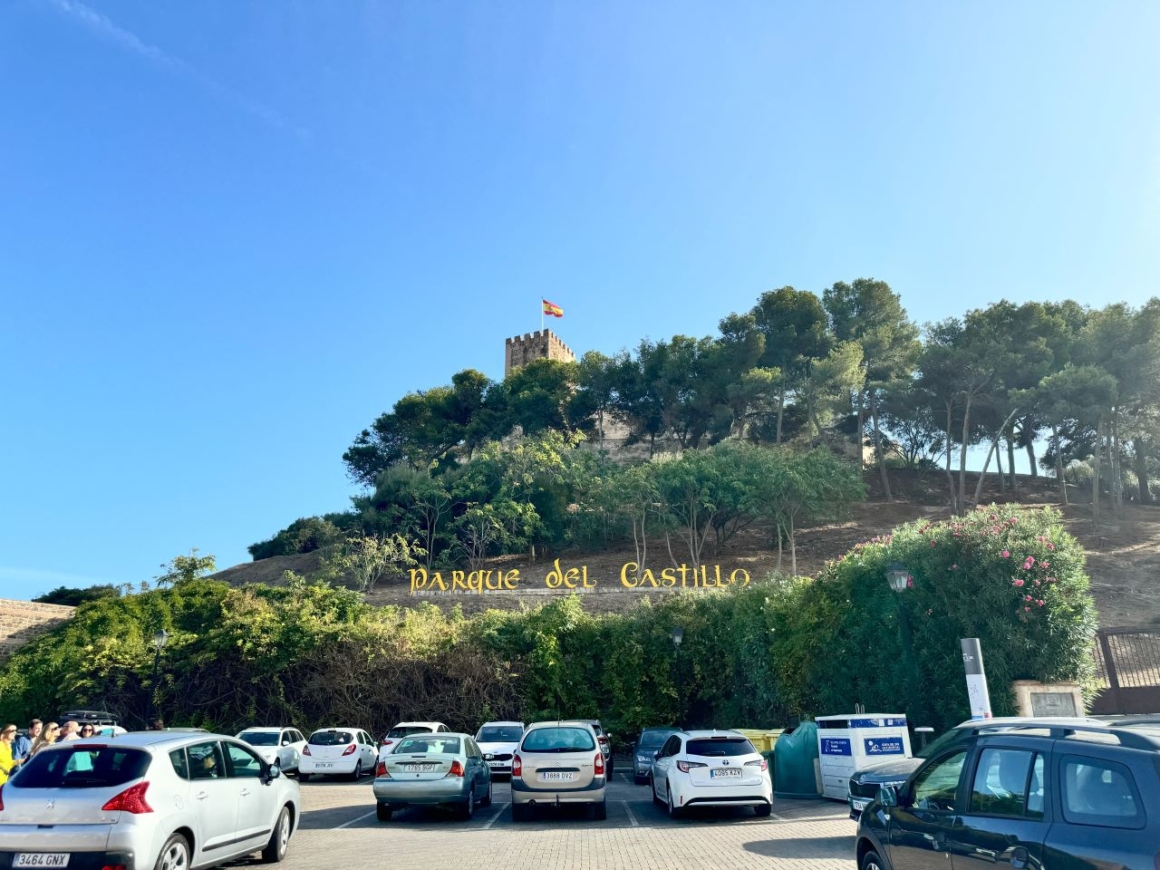
On top of the Castle and on the way to the top there are a few viewpoints. One of the interesting places that can be seen from there is the area of the Marenostrum, a green, open zone that hosts several concerts in Fuengirola.
Along the river, there is another park, sort of. It is more like two sidewalks and a bit of green, but there are some places for entertainment and a few playgrounds.
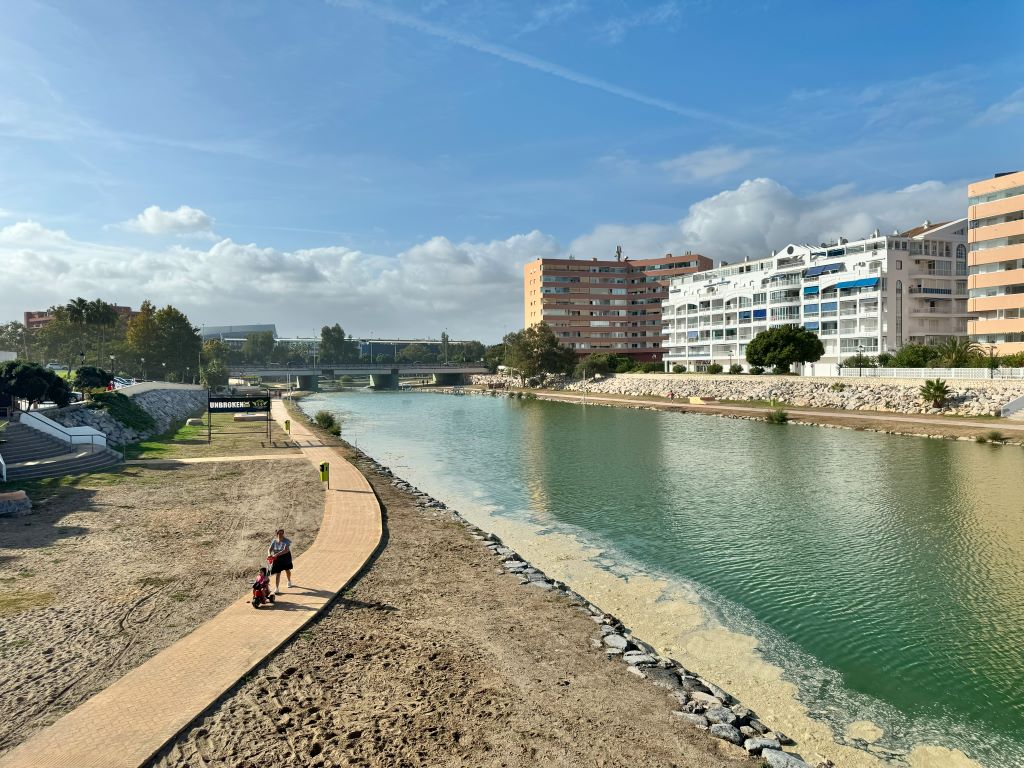
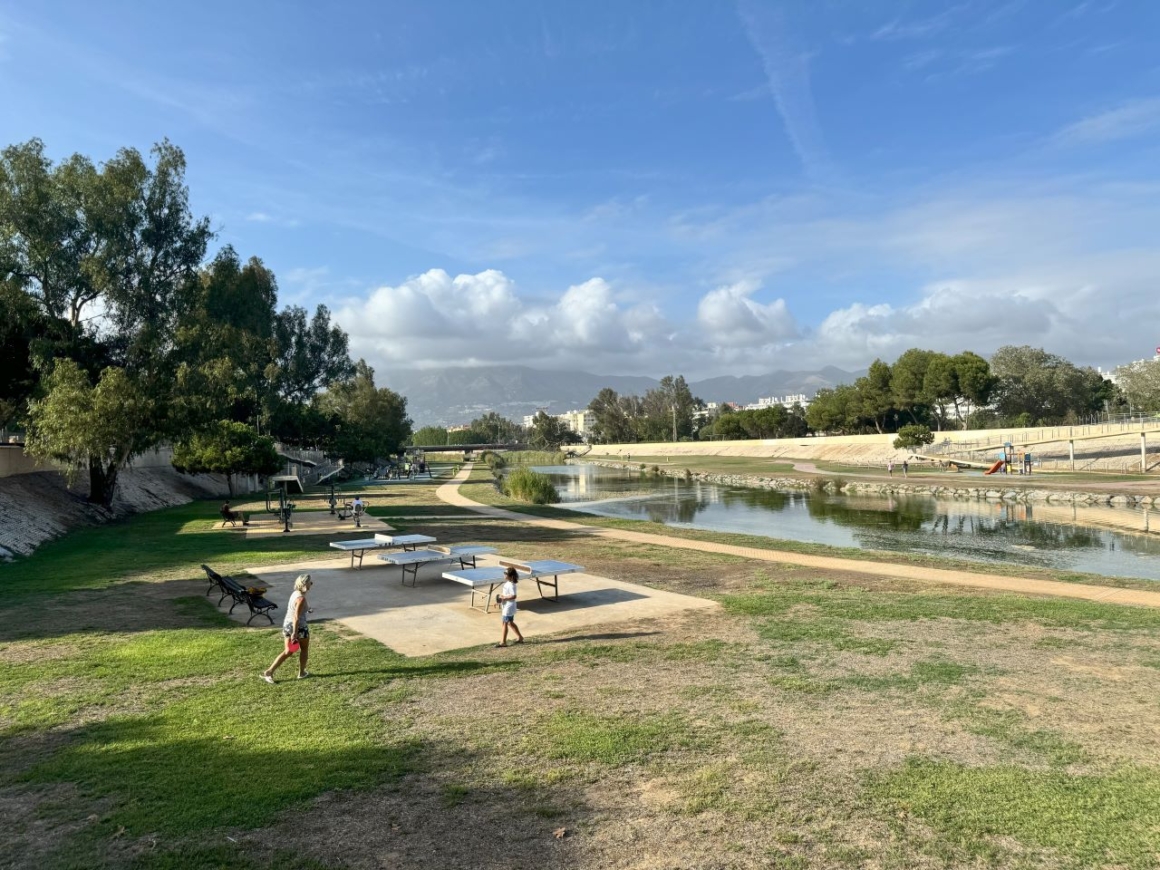
Also in Sohail is the main shopping center of Fuengirola, Miramar. And it has a cinema!
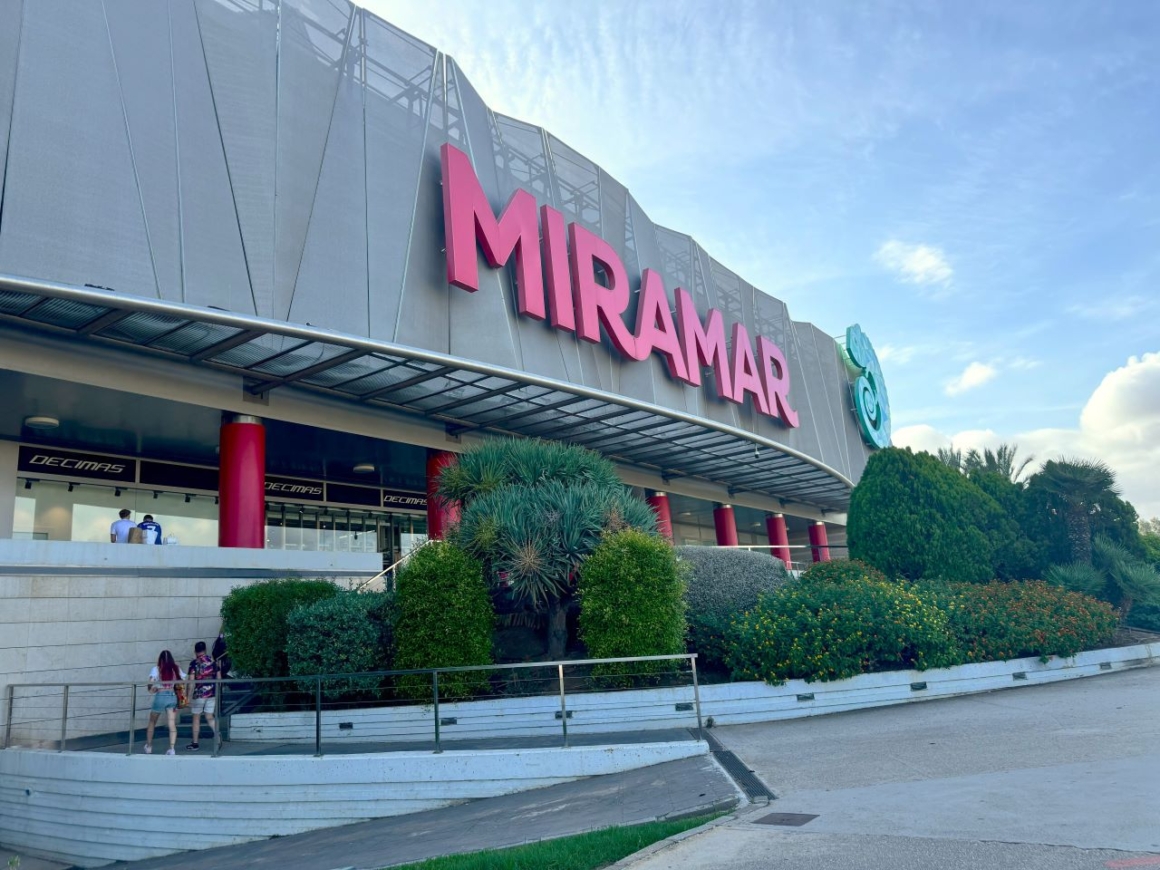

In the very last stretch of sand in Fuengirola, there is a dog beach (we can see a bit of it below). Fuengirola is a very dog-friendly town, with several dog parks and a lot of dog-friendly commerce – such as hotels and vacation rentals that welcome them, restaurants and many grooming places, pet shops and vet clinics.
We reached the end of our walk through the neighborhoods of Fuengirola, but there is something you may have noticed on the way that we should talk about… Have you seen some yellow dots on the floor?
The yellow dot
When walking around Fuengirola, you may come across this intriguing symbol on the pavement:
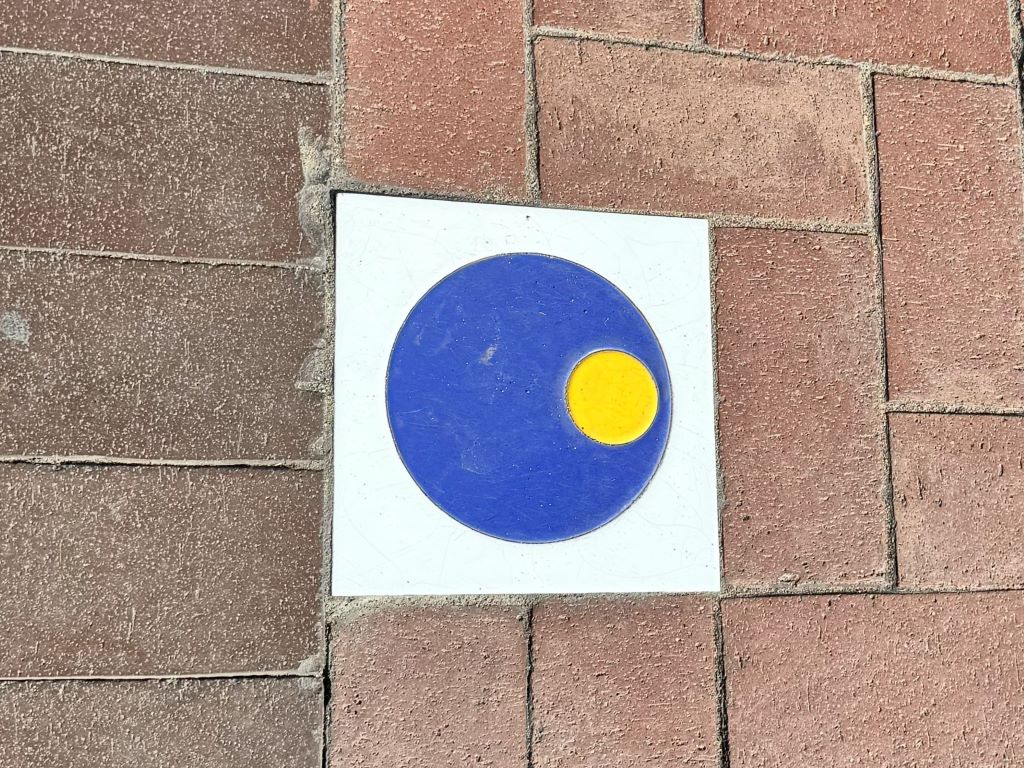
It is called Punto Amarillo (yellow dot) and is usually found near monuments or landmarks. It is part of one of the several urban trails of Fuengirola, and points towards the direction one should go to follow the trail. You can find the trails in the map below; for more information and even to download the routes, check Senderos Urbanos Fuengirola.
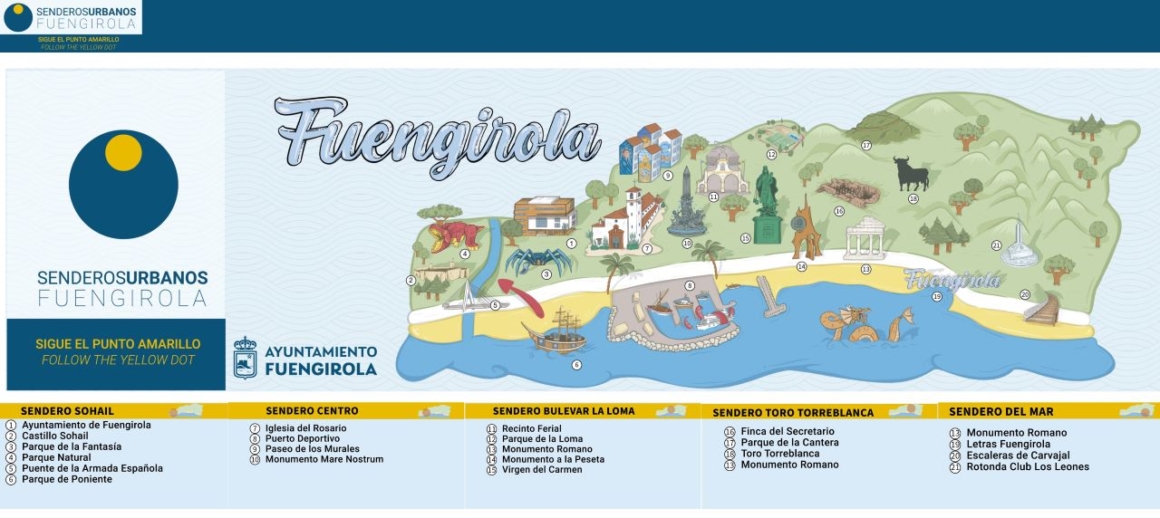
Conclusion
I hope you enjoyed our overview of the neighborhoods of Fuengirola, and maybe now you know a bit more of the city and have chosen a few places you’d like to visit. In my opinion, Fuengirola is a great place for a stroll and for a dip in the sea; it also has many options of ‘entertainment around a table’, with plenty of bars and restaurants all along the city; plenty of cultural activities and a fantastic public transportation system. I think it is very much worth a visit. 😉

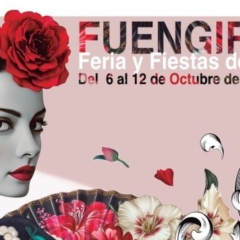
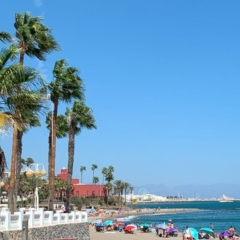
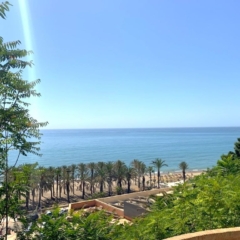
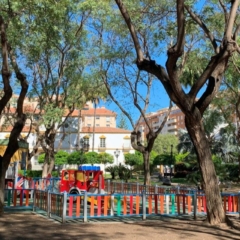

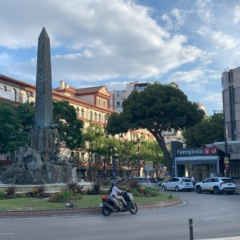

Thank you for the very informative information about Fuengirola. I really enjoyed the insight you provided. My favourite part is definitely Los Boliches. Many thanks
Thank you! I’m happy you liked it!